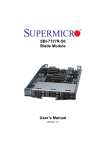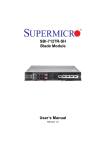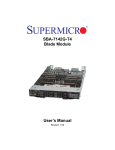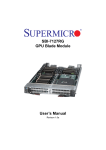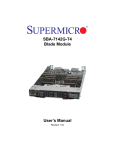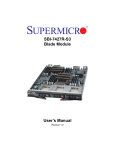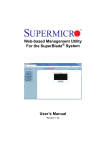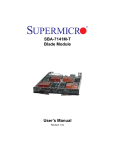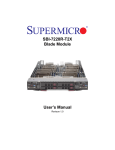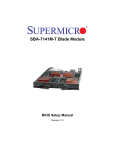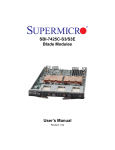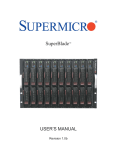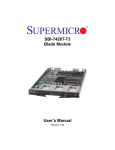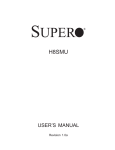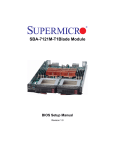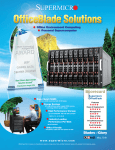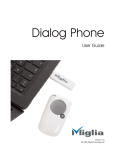Download SBA-7141M-T Blade Module User`s Manual
Transcript
SBA-7141M-T
Blade Module
User’s Manual
Revison 1.0d
SBA-7141M-T Blade Module User’s Manual
The information in this User’s Manual has been carefully reviewed and is believed to be accurate. The
vendor assumes no responsibility for any inaccuracies that may be contained in this document, makes no
commitment to update or to keep current the information in this manual, or to notify any person or
organization of the updates. Please Note: For the most up-to-date version of this manual, please see
our web site at www.supermicro.com.
Super Micro Computer, Inc. ("Supermicro") reserves the right to make changes to the product described
in this manual at any time and without notice. This product, including software and documentation, is the
property of Supermicro and/or its licensors, and is supplied only under a license. Any use or reproduction
of this product is not allowed, except as expressly permitted by the terms of said license.
IN NO EVENT WILL SUPERMICRO BE LIABLE FOR DIRECT, INDIRECT, SPECIAL, INCIDENTAL,
SPECULATIVE OR CONSEQUENTIAL DAMAGES ARISING FROM THE USE OR INABILITY TO USE
THIS PRODUCT OR DOCUMENTATION, EVEN IF ADVISED OF THE POSSIBILITY OF SUCH
DAMAGES. IN PARTICULAR, SUPERMICRO SHALL NOT HAVE LIABILITY FOR ANY HARDWARE,
SOFTWARE, OR DATA STORED OR USED WITH THE PRODUCT, INCLUDING THE COSTS OF
REPAIRING, REPLACING, INTEGRATING, INSTALLING OR RECOVERING SUCH HARDWARE,
SOFTWARE, OR DATA.
Any disputes arising between manufacturer and customer shall be governed by the laws of Santa Clara
County in the State of California, USA. The State of California, County of Santa Clara shall be the
exclusive venue for the resolution of any such disputes. Super Micro's total liability for all claims will not
exceed the price paid for the hardware product.
FCC Statement: This equipment has been tested and found to comply with the limits for a Class A digital
device pursuant to Part 15 of the FCC Rules. These limits are designed to provide reasonable protection
against harmful interference when the equipment is operated in a commercial environment. This
equipment generates, uses, and can radiate radio frequency energy and, if not installed and used in
accordance with the manufacturer’s instruction manual, may cause harmful interference with radio
communications. Operation of this equipment in a residential area is likely to cause harmful interference,
in which case you will be required to correct the interference at your own expense.
California Best Management Practices Regulations for Perchlorate Materials: This Perchlorate warning
applies only to products containing CR (Manganese Dioxide) Lithium coin cells. Perchlorate
Material-special handling may apply. See www.dtsc.ca.gov/hazardouswaste/perchlorate for further
details.
WARNING: HANDLING OF LEAD SOLDER MATERIALS USED IN THIS PRODUCT MAY
EXPOSE YOU TO LEAD, A CHEMICAL KNOWN TO THE STATE OF CALIFORNIA TO
CAUSE BIRTH DEFECTS AND OTHER REPRODUCTIVE HARM.
Manual Revison 1.0d
Release Date: January 30, 2014
Unless you request and receive written permission from Super Micro Computer, Inc., you may not copy
any part of this document.
Information in this document is subject to change without notice. Other products and companies referred
to herein are trademarks or registered trademarks of their respective companies or mark holders.
Copyright © 2014 by Super Micro Computer, Inc.
All rights reserved.
Printed in the United States of America
ii
Preface
About this Manual
This manual is written for professional system integrators, Information Technology
professionals, service personnel and technicians. It provides information for the
installation and use of Supermicro's SBA-7141M-T Blade Module. Installation and
maintenance should be performed by experienced professionals only.
Manual Organization
Chapter 1: Introduction
The first chapter provides a checklist of the main components included with the
SBA-7141M-T Blade Module and describes its main features.
Chapter 2: Standardized Warning Statements
You should familiarize yourself with this chapter for a general overview of safety
precautions that should be followed when installing and servicing the SBA-7141M-T
Blade Module.
Chapter 3: Setup and Installation
Refer to this chapter for details on installing the SBA-7141M-T Blade Module into the
SuperBladeSuperBlade chassis. Other sections cover the installation and placement of
memory modules and the installation of hard disk drives into the blade module.
Chapter 4: Blade Module Features
This chapter coves features and component information about the SBA-7141M-T Blade
Module. Included here are descriptions and information for mainboard components,
connectors, LEDs and other features of the blade module.
Chapter 5: BIOS
BIOS setup is covered in this chapter for the SBA-7141M-T Blade Module.
Appendix A: BIOS POST Codes
BIOS POST Codes for the SBA-7141M-T Blade Module are explained in this appendix.
iii
SBA-7141M-T Blade Module User’s Manual
Notes
iv
Table of Contents
Chapter 1 Introduction....................................................................... 1-1
1-1 Overview ............................................................................................. 1-1
1-2 Product Checklist of Typical Components..................................... 1-1
1-3 Product Checklist of Typical Components..................................... 1-2
1-4 Blade Module Features .................................................................... 1-2
Processors .............................................................................................. 1-2
Memory ................................................................................................... 1-3
Storage.................................................................................................... 1-3
Density .................................................................................................... 1-3
1-5 Contacting Supermicro ..................................................................... 1-4
Chapter 2 Standardized Warning Statements ..................... 2-1
2-1 About Standardized Warning Statements ...................................... 2-1
Warning Definition................................................................................... 2-1
Installation Instructions ........................................................................... 2-3
Circuit Breaker ........................................................................................ 2-4
Power Disconnection Warning ................................................................ 2-5
Equipment Installation............................................................................. 2-6
Restricted Area ....................................................................................... 2-7
Battery Handling ..................................................................................... 2-9
Redundant Power Supplies .................................................................. 2-10
Backplane Voltage ................................................................................ 2-11
Comply with Local and National Electrical Codes................................. 2-12
Product Disposal................................................................................... 2-13
Hot Swap Fan Warning ......................................................................... 2-14
Power Cable and AC Adapter .............................................................. 2-15
Chapter 3 Setup and Installation ................................................. 3-1
3-1 Overview ............................................................................................. 3-1
3-2 Installing Blade Modules .................................................................. 3-1
Powering Up a Blade Unit....................................................................... 3-1
Powering Down a Blade Unit .................................................................. 3-1
Removing a Blade Unit from the Enclosure ............................................ 3-1
Removing/Replacing the Blade Cover .................................................... 3-2
Installing a Blade Unit into the Enclosure ............................................... 3-2
3-3 Processor Installation ....................................................................... 3-4
v
SBA-7141M-T Blade Module User’s Manual
3-4 Onboard Battery Installation ............................................................ 3-5
3-5 Memory ............................................................................................... 3-5
Populating Memory Slots ........................................................................ 3-6
DIMM Installation .................................................................................... 3-8
3-6 Hard Disk Drive Installation ............................................................. 3-8
3-7 Installing the Operating System ...................................................... 3-9
Installing with an External USB CD-ROM Drive...................................... 3-9
Installing via PXE Boot............................................................................ 3-9
Installing via Virtual Media (Drive Redirection) ..................................... 3-10
3-8 Management Software ................................................................... 3-10
3-9 Configuring and Setting up RAID ................................................. 3-10
Chapter 4 Blade Module Features .............................................. 4-1
4-1 Control Panel ..................................................................................... 4-2
Power Button .......................................................................................... 4-3
KVM Button............................................................................................. 4-3
LED Indicators ........................................................................................ 4-3
KVM Connector....................................................................................... 4-3
4-2 Mainboard........................................................................................... 4-4
Jumpers .................................................................................................. 4-5
CMOS Clear............................................................................................ 4-6
4-3 Blade Unit Components ................................................................... 4-6
Memory Support ..................................................................................... 4-7
Hard Disk Drives ..................................................................................... 4-7
Chapter 5 BIOS ....................................................................................... 5-1
5-1 Introduction......................................................................................... 5-1
System BIOS .......................................................................................... 5-1
How To Change the Configuration Data ................................................. 5-1
Starting the Setup Utility.......................................................................... 5-1
5-2 BIOS Updates .................................................................................... 5-2
Flashing BIOS......................................................................................... 5-2
5-3 Running Setup ................................................................................... 5-3
5-4 Main BIOS Setup Menu ................................................................... 5-3
System Time/System Date ..................................................................... 5-4
5-5 Advanced Settings Menu ................................................................. 5-4
BOOT Settings Configuration ................................................................. 5-5
CPU Configuration .................................................................................. 5-6
vi
SATA Configuration................................................................................. 5-7
PCI/PnP Configuration............................................................................ 5-7
Super IO Configuration ........................................................................... 5-8
Chipset Configuration ............................................................................. 5-8
NorthBridge Configuration.................................................................... 5-9
SouthBridge/MCP55 Configuration .................................................... 5-10
Event Log Configuration ....................................................................... 5-11
PCI Express Configuration.................................................................... 5-11
Remote Access Configuration .............................................................. 5-12
System Health Monitor.......................................................................... 5-12
5-6 Boot Menu ........................................................................................ 5-13
5-7 Security Menu .................................................................................. 5-13
5-8 Exit Menu .......................................................................................... 5-14
Appendix A BIOS POST Codes ....................................................A-1
A-1 BIOS POST Messages ....................................................................A-1
A-2 BIOS POST Codes ...........................................................................A-3
Recoverable POST Errors ......................................................................A-4
Terminal POST Errors.............................................................................A-4
vii
SBA-7141M-T Blade Module User’s Manual
Notes
viii
List of Figures
Figure 3-1. Inserting a Blade into the Enclosure ............................................... 3-3
Figure 3-2. Locking the Blade into Position....................................................... 3-3
Figure 3-3. Installing a Processor in a Socket................................................... 3-5
Figure 3-4. Installing the Onboard Battery ........................................................ 3-5
Figure 3-5. 16-slot DIMM Numbering................................................................ 3-7
Figure 3-6. Installing a DIMM into a Memory Slot ............................................. 3-8
Figure 4-1. SBA-7141M-T Blade Unit Front View ............................................. 4-1
Figure 4-2. Blade Control Panel........................................................................ 4-2
Figure 4-3. BHQME Mainboard......................................................................... 4-4
Figure 4-4. NVidia MCP55 Pro Chipset: Block Diagram for SBA-7141M-T ...... 4-5
Figure 4-5. Exploded View of SBA-7141M-T Blade Module ............................. 4-6
ix
SBA-7141M-T Blade Module User’s Manual
Notes
x
List of Tables
Table 1-1. SBA-7141M-T Blade Specification Features ................................... 1-2
Table 3-1. Populating 16 Memory Slots and 4 CPUs for Interleaved
Operation .......................................................................................................... 3-6
Table 4-1. SBA-7141M-T Blade Unit Features ................................................. 4-1
Table 4-2. Blade Control Panel ......................................................................... 4-2
Table 4-3. Blade Module LED Indicators .......................................................... 4-3
Table 4-4. BHQME Mainboard Layout .............................................................. 4-5
Table 4-5. Main Components of SBA-7141M-T Blade Module ......................... 4-7
Table 5-1. BOOT Settings Configuration Submenu .......................................... 5-5
Table 5-2. CPU Configuration Submenu........................................................... 5-6
Table 5-3. SATA Configuration Submenu......................................................... 5-7
Table 5-4. PCI/PnP Configuration Submenu .................................................... 5-7
Table 5-5. Super IO Configuration Submenu.................................................... 5-8
Table 5-6. Chipset Configuration Submenu ...................................................... 5-8
Table 5-7. NorthBridge Configuration Submenu ............................................... 5-9
Table 5-8. SouthBridge/MCP55 Configuration Submenu ............................... 5-10
Table 5-9. Event Log Configuration Submenu ................................................ 5-11
Table 5-10. PCI Express Configuration Submenu .......................................... 5-11
Table 5-11. Remote Access Configuration Submenu ..................................... 5-12
Table 5-12. System Health Monitor Submenu ................................................ 5-12
Table 5-13. Boot menu.................................................................................... 5-13
Table 5-14. Security Menu .............................................................................. 5-13
Table 5-15. Exit Menu ..................................................................................... 5-14
Table A-1. BIOS POST Messages....................................................................A-1
Table A-2. Terminal POST Errors .....................................................................A-4
Table A-3. Boot Block Flash ROM Terminal POST Errors................................A-8
xi
SBA-7141M-T Blade Module User’s Manual
Notes
xii
Chapter 1
Introduction
1-1
Overview
The SBA-7141M-T blade module is a compact self-contained server that connects into a
pre-cabled enclosure that provides power, cooling, management and networking
functions. One enclosure for the SBA-7141M-T blade module can hold ten blade units.
In this manual, “blade system” refers to the entire system (including the enclosure and
blades units), “blade” or “blade unit” refers to a single blade module and “blade
enclosure” is the chassis that the blades, power supplies and modules are housed in.
Please refer to our web site for information on operating systems that have been
certified for use with the SuperBlade (www.supermicro.com/products/superblade/).
1-2
Product Checklist of Typical Components
Your blade module ships with its mainboard already installed in its chassis. Memory,
hard disk drives and the CPU must all be installed by the user after shipment. See
Chapter 3: "Setup and Installation" on page 3-1 for details on installation of these
components.
Aside from the blade module unit itself, the following optional add-on cards may be
ordered for your blade module:
•
Blade IPMI Add-on Card: AOC-SIMBL
•
Mezzanine Cards (with Infiniband Switch): AOC-IBH-XDD, AOC-IBH-XDS or
AOC-IBH-002
Please refer to our web site for information on operating systems that have been
certified for use with the SuperBlade (www.supermicro.com/products/superblade/).
Note: For your system to work properly, please follow the links below to download all
necessary drivers/utilities and the user’s manual for your server.
•
Supermicro product manuals: http://www.supermicro.com/support/manuals/
•
Product drivers and utilities: ftp://ftp.supermicro.com
•
Product safety information: http://super-dev/about/policies/safety_information.cfm
•
If you have any questions, please contact our support team at:
[email protected]
Note: A complete list of safety warnings is provided on the Supermicro web site at
http://www.supermicro.com/about/policies/safety_information.cfm.
1-1
SBA-7141M-T Blade Module User’s Manual
1-3
Product Checklist of Typical Components
Your blade module ships with its mainboard already installed in its chassis. Memory,
hard disk drives and the CPU must all be installed by the user after shipment. See
Chapter 3: "Setup and Installation" on page 3-1 for details on installation of these
components.
Aside from the blade module unit itself, the optional AOC-XEH-iN2 Mezzanine add-on
card (with 10G Pass-Through or 10G Switch) may be ordered for your blade module
along with the following add-on cards:
•
AOC-XEH-iN2
•
AOC-IBH-XDD
•
AOC-IBH-XQD
•
AOC-IBH-XQS
•
AOC-IBH-XDS
See the Supermicro website and the SuperBlade Network Modules User’s Manual on
your SuperBlade system’s CD-ROM for more details on these add-on cards.
1-4
Blade Module Features
Table 1-1 lists the main features of the SBA-7141M-T blade module. See the proceeding
section for components typically included in a blade system and other optional
components. Specific details on the SBA-7141M-T blade module is found in Chapter 4:
"Blade Module Features" on page 4-1.
Table 1-1. SBA-7141M-T Blade Specification Features
Mainboard
BHQME (proprietary form factor)
Chassis Dimensions (HxWxD): 11.32” x 1.67” x 18.5”
Processors
Supports four AMD Opteron 8300/8200 series processors. Please refer to
our web site for a complete listing of supported processors.
FSB Speed
1000 MHz Hyper Transport front side (system) bus speed
Chipset
Nvidia MCP55 Pro
Graphics Controller
Onboard ATI ES1000 graphics chip with 16MB of SDRAM
BIOS
8 Mb AMI® Flash ROM
Memory Capacity
Eight 240-pin DIMM sockets supporting up to 128 GB of ECC Registered
DDR2-800/667/533 SDRAM.
SATA Controller
Nvidia MCP55 Pro on-chip controller for two Serial ATA drives
Hard Drive Bays
One Internal 2.5" SATA hard disk drive
Processors
The SBA-7141M-T blade module supports up to four AMD Opteron 8300/8200 series
processors.
1-2
Chapter 1: Introduction
Refer to the Supermicro web site for a complete listing of supported processors (http://
www.supermicro.com/products/superblade). Please note that you will need to check the
detailed specifications of a particular blade module for a list of the CPUs it supports.
Details on installation of the processor into the SBA-7141M-T blade module are found in
Chapter 3: "Setup and Installation" on page 3-1.
Memory
The BHQME supports single or dual-channel, registered ECC DDR2-800/667/533
SDRAM in sixteen DIMM sockets. Both interleaved and non-interleaved memory are
supported, so you may populate any number of DIMM slots. Populating two adjacent
slots at a time with memory modules of the same size and type will result in interleaved
(128-bit) memory, which is faster than non-interleaved (64-bit) memory.
Please refer to the Supermicro web site for a list of supported memory
(www.supermicro.com/products/superblade). The detailed specifications for a blade
module will contain a link to a list of recommended memory sizes and manufacturers.
Details on installation of memory modules into the SBA-7141M-T blade module are
found in Chapter 3: "Setup and Installation" on page 3-1.
Storage
The SBA-7141M-T blade module accommodates one internal 2.5" SATA hard disk drive,
which is mounted directly on the blade’s mainboard. See Chapter 3: "Setup and
Installation" on page 3-1 for storage installation details.
Density
A maximum of ten blade modules may be installed into a single blade enclosure. Each
blade enclosure is a 7U form factor, so a standard 42U rack may accommodate up to six
enclosures with 60 blade modules, or the equivalent of 60 1U servers. With the inclusion
of six CMM modules, twelve Gigabit Ethernet switches and six InfiniBand switches, this
would occupy up to 84U space in a conventional 1U server configuration.
1-3
SBA-7141M-T Blade Module User’s Manual
1-5
Contacting Supermicro
Headquarters
Address:
Super Micro Computer, Inc.
980 Rock Ave.
San Jose, CA 95131 U.S.A.
Tel:
Fax:
+1 (408) 503-8000
+1 (408) 503-8008
[email protected] (General Information)
Email:
[email protected] (Technical Support)
Web Site:
www.supermicro.com
Europe
Address:
Super Micro Computer B.V.
Het Sterrenbeeld 28, 5215 ML
‘s-Hertogenbosch, The Netherlands
Tel:
+31 (0) 73-6400390
Fax:
+31 (0) 73-6416525
[email protected] (General Information)
Email:
[email protected] (Technical Support)
[email protected] (Customer Support)
Asia-Pacific
Address:
Super Micro Computer, Inc.
3F, No. 150, Jian 1st Rd.
Zhonghe Dist., New Taipei City 23511
Taiwan (R.O.C)
Tel:
+886-(2) 8226-3990
Fax:
+886-(2) 8226-3992
Web Site:
www.supermicro.com.tw
Technical Support:
Email:
[email protected]
Tel:
+886-(2)-8226-3990
1-4
Chapter 2
Standardized Warning Statements
2-1
About Standardized Warning Statements
The following statements are industry standard warnings, provided to warn the user of
situations which have the potential for bodily injury. Should you have questions or
experience difficulty, contact Supermicro's Technical Support department for assistance.
Only certified technicians should attempt to install or configure components.
Read this appendix in its entirety before installing or configuring components in the
Supermicro chassis
These warnings may also be found on our web site at http://
www.supermicro.com/about/policies/safety_information.cfm.
Warning Definition
Warning!
This warning symbol means danger. You are in a situation that could cause
bodily injury. Before you work on any equipment, be aware of the hazards
involved with electrical circuitry and be familiar with standard practices for preventing
accidents.
警告の定義
この警告サインは危険を意味します。
人身事故につながる可能性がありますので、いずれの機器でも動作させる前に、
電気回路に含まれる危険性に注意して、標準的な事故防止策に精通して下さい。
此警告符号代表危险。
您正处于可能受到严重伤害的工作环境中。在您使用设备开始工作之前,必须充分意识到
触电的危险,并熟练掌握防止事故发生的标准工作程序。请根据每项警告结尾的声明号码
找到此设备的安全性警告说明的翻译文本。
此警告符號代表危險。
您正處於可能身體可能會受損傷的工作環境中。在您使用任何設備之前,請注意觸電的危
險,並且要熟悉預防事故發生的標準工作程序。請依照每一注意事項後的號碼找到相關的
翻譯說明內容。
2-1
SBA-7141M-T Blade Module User’s Manual
Warnung
WICHTIGE SICHERHEITSHINWEISE
Dieses Warnsymbol bedeutet Gefahr. Sie befinden sich in einer Situation, die zu
Verletzungen führen kann. Machen Sie sich vor der Arbeit mit Geräten mit den Gefahren
elektrischer Schaltungen und den üblichen Verfahren zur Vorbeugung vor Unfällen
vertraut. Suchen Sie mit der am Ende jeder Warnung angegebenen
Anweisungsnummer nach der jeweiligen Übersetzung in den übersetzten
Sicherheitshinweisen, die zusammen mit diesem Gerät ausgeliefert wurden.
BEWAHREN SIE DIESE HINWEISE GUT AUF.
INSTRUCCIONES IMPORTANTES DE SEGURIDAD
Este símbolo de aviso indica peligro. Existe riesgo para su integridad física. Antes de
manipular cualquier equipo, considere los riesgos de la corriente eléctrica y
familiarícese con los procedimientos estándar de prevención de accidentes. Al final de
cada advertencia encontrará el número que le ayudará a encontrar el texto traducido en
el apartado de traducciones que acompaña a este dispositivo.
GUARDE ESTAS INSTRUCCIONES.
IMPORTANTES INFORMATIONS DE SÉCURITÉ
Ce symbole d'avertissement indique un danger. Vous vous trouvez dans une situation
pouvant entraîner des blessures ou des dommages corporels. Avant de travailler sur un
équipement, soyez conscient des dangers liés aux circuits électriques et
familiarisez-vous avec les procédures couramment utilisées pour éviter les accidents.
Pour prendre connaissance des traductions des avertissements figurant dans les
consignes de sécurité traduites qui accompagnent cet appareil, référez-vous au numéro
de l'instruction situé à la fin de chaque avertissement.
CONSERVEZ CES INFORMATIONS.
±³±¯¨©°³
¥ ¢©§²§³²§³±¢¥³©§¥«¢¢²«³¢©°³¢¥«³±¨³³±¯
¤¢§³³°¥ §¦«±²°±¯¢¥²¢¢²¥¤¢«³¥°³¢³¥²²¢¢§³¢±²³¢¢
¦¢¢¤±³±¢¥¨¢°³¥¦¢²±¥¦¢¤§ª§¦¢©¤¡±°¢§±ª¥²³¢©¤¡ ±°¢§±ª¢±§¦¢¢¤±³±³©°³¢©¥¥§ ª©³ ±°¥²¢
. ﺗﺤﺬﻳﺮ!ﻫﺬﺍ ﺍﻟﺮﻣﺰ ﻳﻌﻨﻲ ﺧﻄﺮ ﺍﻧﻚ ﻓﻲ ﺣﺎﻟﺔ ﻳﻤﻜﻦ ﺃﻥ ﺗﺘﺴﺒﺐ ﻓﻲ ﺍﺻﺎﺑﺔ ﺟﺴﺪﻳﺔ
ﻛﻦ ﻋﻠﻰ ﻋﻠﻢ ﺑﺎﻟﻤﺨﺎﻁﺮ ﺍﻟﻨﺎﺟﻤﺔ ﻋﻦ ﺍﻟﺪﻭﺍﺋﺮ،ﻗﺒﻞ ﺃﻥ ﺗﻌﻤﻞ ﻋﻠﻰ ﺃﻱ ﻣﻌﺪﺍﺕ
ﺍﻟﻜﻬﺮﺑﺎﺋﻴﺔ
ﻭﻛﻦ ﻋﻠﻰ ﺩﺭﺍﻳﺔ ﺑﺎﻟﻤﻤﺎﺭﺳﺎﺕ ﺍﻟﻮﻗﺎﺋﻴﺔ ﻟﻤﻨﻊ ﻭﻗﻮﻉ ﺃﻱ ﺣﻮﺍﺩﺙ
ﺍﺳﺘﺨﺪﻡ ﺭﻗﻢ ﺍﻟﺒﻴﺎﻥ ﺍﻟﻤﻨﺼﻮﺹ ﻓﻲ ﻧﻬﺎﻳﺔ ﻛﻞ ﺗﺤﺬﻳﺮ ﻟﻠﻌﺜﻮﺭ ﺗﺮﺟﻤﺘﻬﺎ
안전을 위한 주의사항
2-2
Chapter 2: Standardized Warning Statements
경고 !
이 경고 기호는 위험이 있음을 알려 줍니다 . 작업자의 신체에 부상을 야기 할 수 있는
상태에 있게 됩니다 . 모든 장비에 대한 작업을 수행하기 전에 전기회로와 관련된 위험
요소들을 확인하시고 사전에 사고를 방지할 수 있도록 표준 작업절차를 준수해 주시기
바랍니다 .
해당 번역문을 찾기 위해 각 경고의 마지막 부분에 제공된 경고문 번호를 참조하십시오
BELANGRIJKE VEILIGHEIDSINSTRUCTIES
Dit waarschuwings symbool betekent gevaar. U verkeert in een situatie die lichamelijk
letsel kan veroorzaken. Voordat u aan enige apparatuur gaat werken, dient u zich
bewust te zijn van de bij een elektrische installatie betrokken risico's en dient u op de
hoogte te zijn van de standaard procedures om ongelukken te voorkomen. Gebruik de
nummers aan het eind van elke waarschuwing om deze te herleiden naar de
desbetreffende locatie.
BEWAAR DEZE INSTRUCTIES
Installation Instructions
Warning!
Read the installation instructions before connecting the system to the power
source.
設置手順書
システムを電源に接続する前に、設置手順書をお読み下さい。
警告
将此系统连接电源前 , 请先阅读安装说明。
警告
將系統與電源連接前,請先閱讀安裝說明。
Warnung
Vor dem Anschließen des Systems an die Stromquelle die Installationsanweisungen
lesen.
¡Advertencia!
Lea las instrucciones de instalación antes de conectar el sistema a la red de
alimentación.
Attention
Avant de brancher le système sur la source d'alimentation, consulter les directives
d'installation.
2-3
SBA-7141M-T Blade Module User’s Manual
.יש לקרוא את הוראות התקנה לפני חיבור המערכת למקור מתח
ﺍﻗﺮ ﺇﺭﺷﺎﺩﺍﺕ ﺍﻟﺘﺮﻛﻴﺐ ﻗﺒﻞ ﺗﻮﺻﻴﻞ ﺍﻟﻨﻈﺎﻡ ﺇﻟﻰ ﻣﺼﺪﺭ ﻟﻠﻄﺎﻗﺔ
시스템을 전원에 연결하기 전에 설치 안내를 읽어주십시오 .
Waarschuwing
Raadpleeg de installatie-instructies voordat u het systeem op de voedingsbron aansluit.
Circuit Breaker
Warning!
This product relies on the building's installation for short-circuit (overcurrent)
protection. Ensure that the protective device is rated not greater than: 250 V,
20 A.
サーキット・ブレーカー
この製品は、短絡(過電流)保護装置がある建物での設置を前提としています。
保護装置の定格が 250 V、20 A を超えないことを確認下さい。
警告
此产品的短路 ( 过载电流 ) 保护由建筑物的供电系统提供 , 确保短路保护设备的额定电流
不大于 250V,20A。
警告
此產品的短路 ( 過載電流 ) 保護由建築物的供電系統提供 , 確保短路保護設備的額定電
流不大於 250V,20A。
Warnung
Dieses Produkt ist darauf angewiesen, dass im Gebäude ein Kurzschluss- bzw.
Überstromschutz installiert ist. Stellen Sie sicher, dass der Nennwert der
Schutzvorrichtung nicht mehr als: 250 V, 20 A beträgt.
¡Advertencia!
Este equipo utiliza el sistema de protección contra cortocircuitos (o sobrecorrientes) del
edificio. Asegúrese de que el dispositivo de protección no sea superior a: 250 V, 20 A.
Attention
Pour ce qui est de la protection contre les courts-circuits (surtension), ce produit dépend
de l'installation électrique du local. Vérifiez que le courant nominal du dispositif de
protection n'est pas supérieur à :250 V, 20 A.
יש לוודא כי.מוצר זה מסתמך על הגנה המותקנת במבנים למניעת קצר חשמלי
250 V, 20 A-המכשיר המגן מפני הקצר החשמלי הוא לא יותר מ
2-4
Chapter 2: Standardized Warning Statements
ﻫﺬﺍ ﺍﻟﻤﻨﺘﺞ ﻳﻌﺘﻤﺪ ﻋﻠﻰ ﻣﻌﺪﺍﺕ ﺍﻟﺤﻤﺎﻳﺔ ﻣﻦ ﺍﻟﺪﻭﺍﺋﺮﺍﻟﻘﺼﻴﺮﺓ ﺍﻟﺘﻲ ﺗﻢ ﺗﺜﺒﻴﺘﻬﺎ ﻓﻲ
ﺍﻟﻤﺒﻨﻰ
20A, 250V :ﺗﺄﻛﺪ ﻣﻦ ﺃﻥ ﺗﻘﻴﻴﻢ ﺍﻟﺠﻬﺎﺯ ﺍﻟﻮﻗﺎﺋﻲ ﻟﻴﺲ ﺃﻛﺜﺮ ﻣﻦ
경고 !
이 제품은 전원의 단락 ( 과전류 ) 방지에 대해서 전적으로 건물의 관련 설비에 의존합니
다 . 보호장치의 정격이 반드시 250V( 볼트 ), 20A( 암페어 ) 를 초과하지 않도록 해야
합니다 .
Waarschuwing
Dit product is afhankelijk van de kortsluitbeveiliging (overspanning) van uw electrische
installatie. Controleer of het beveiligde aparaat niet groter gedimensioneerd is dan
220V, 20A.
Power Disconnection Warning
Warning!
The system must be disconnected from all sources of power and the power
cord removed from the power supply module(s) before accessing the chassis
interior to install or remove system components.
電源切断の警告
システムコンポーネントの取り付けまたは取り外しのために、シャーシー内部にアクセ
スするには、
システムの電源はすべてのソースから切断され、電源コードは電源モジュールから取り
外す必要があります。
警告
在你打开机箱并安装或移除内部器件前 , 必须将系统完全断电 , 并移除电源线。
警告
在您打開機殼安裝或移除內部元件前,必須將系統完全斷電,並移除電源線。
Warnung
Das System muss von allen Quellen der Energie und vom Netzanschlusskabel getrennt
sein, das von den Spg.Versorgungsteilmodulen entfernt wird, bevor es auf den
Chassisinnenraum zurückgreift, um Systemsbestandteile anzubringen oder zu
entfernen.
2-5
SBA-7141M-T Blade Module User’s Manual
¡Advertencia!
El sistema debe ser disconnected de todas las fuentes de energía y del cable eléctrico
quitado de los módulos de fuente de alimentación antes de tener acceso el interior del
chasis para instalar o para quitar componentes de sistema.
Attention
Le système doit être débranché de toutes les sources de puissance ainsi que de son
cordon d'alimentation secteur avant d'accéder à l'intérieur du chassis pour installer ou
enlever des composants de systéme.
אזהרה מפני ניתוק חשמלי
!אזהרה
יש לנתק את המערכת מכל מקורות החשמל ויש להסיר את כבל החשמלי מהספק
.לפני גישה לחלק הפנימי של המארז לצורך התקנת או הסרת רכיבים
ﻳﺠﺐ ﻓﺼﻞ ﺍﻟﻨﻈﺎﻡ ﻣﻦ ﺟﻤﻴﻊ ﻣﺼﺎﺩﺭ ﺍﻟﻄﺎﻗﺔ ﻭﺇﺯﺍﻟﺔ ﺳﻠﻚ ﺍﻟﻜﻬﺮﺑﺎء ﻣﻦ ﻭﺣﺪﺓ ﺍﻣﺪﺍﺩ
ﺍﻟﻄﺎﻗﺔ ﻗﺒﻞ
ﺍﻟﻮﺻﻮﻝ ﺇﻟﻰ ﺍﻟﻤﻨﺎﻁﻖ ﺍﻟﺪﺍﺧﻠﻴﺔ ﻟﻠﻬﻴﻜﻞ ﻟﺘﺜﺒﻴﺖ ﺃﻭ ﺇﺯﺍﻟﺔ ﻣﻜﻮﻧﺎﺕ ﺍﻟﺠﻬﺎﺯ
경고 !
시스템에 부품들을 장착하거나 제거하기 위해서는 섀시 내부에 접근하기 전에 반드시
전원 공급장치로부터 연결되어있는 모든 전원과 전기코드를 분리해주어야 합니다 .
Waarschuwing
Voordat u toegang neemt tot het binnenwerk van de behuizing voor het installeren of
verwijderen van systeem onderdelen, dient u alle spanningsbronnen en alle
stroomkabels aangesloten op de voeding(en) van de behuizing te verwijderen.
Equipment Installation
Warning!
Only trained and qualified personnel should be allowed to install, replace, or
service this equipment.
機器の設置
トレーニングを受け認定された人だけがこの装置の設置、交換、またはサービスを許
可されています。
警告
只有经过培训且具有资格的人员才能进行此设备的安装、更换和维修。
警告
只有經過受訓且具資格人員才可安裝、更換與維修此設備。
2-6
Chapter 2: Standardized Warning Statements
Warnung
Das Installieren, Ersetzen oder Bedienen dieser Ausrüstung sollte nur geschultem,
qualifiziertem Personal gestattet werden.
¡Advertencia!
Solamente el personal calificado debe instalar, reemplazar o utilizar este equipo.
Attention
Il est vivement recommandé de confier l'installation, le remplacement et la maintenance
de ces équipements à des personnels qualifiés et expérimentés.
!אזהרה
. להחליף את הציוד או לתת שירות עבור הציוד,צוות מוסמך בלבד רשאי להתקין
ﻳﺠﺐ ﺃﻥ ﻳﺴﻤﺢ ﻓﻘﻂ ﻟﻠﻤﻮﻅﻔﻴﻦ ﺍﻟﻤﺆﻫﻠﻴﻦ ﻭﺍﻟﻤﺪﺭﺑﻴﻦ ﻟﺘﺮﻛﻴﺐ ﻭﺍﺳﺘﺒﺪﺍﻝ ﺃﻭ ﺧﺪﻣﺔ ﻫﺬﺍ ﺍﻟﺠﻬﺎﺯ
경고 !
훈련을 받고 공인된 기술자만이 이 장비의 설치 , 교체 또는 서비스를 수행할 수 있습니
다.
Waarschuwing
Deze apparatuur mag alleen worden geïnstalleerd, vervangen of hersteld door
geschoold en gekwalificeerd personeel.
Restricted Area
Warning!
This unit is intended for installation in restricted access areas. A restricted
access area can be accessed only through the use of a special tool, lock and
key, or other means of security. (This warning does not apply to workstations).
アクセス制限区域
このユニットは、アクセス制限区域に設置されることを想定しています。
アクセス制限区域は、特別なツール、鍵と錠前、その他のセキュリティの手段を用い
てのみ出入りが可能です。
警告
此部件应安装在限制进出的场所,限制进出的场所指只能通过使用特殊工具、锁和钥匙或
其它安全手段进出的场所。
警告
此裝置僅限安裝於進出管制區域,進出管制區域係指僅能以特殊工具、鎖頭及鑰匙或其
他安全方式才能進入的區域。
2-7
SBA-7141M-T Blade Module User’s Manual
Warnung
Diese Einheit ist zur Installation in Bereichen mit beschränktem Zutritt vorgesehen. Der
Zutritt zu derartigen Bereichen ist nur mit einem Spezialwerkzeug, Schloss und
Schlüssel oder einer sonstigen Sicherheitsvorkehrung möglich.
¡Advertencia!
Esta unidad ha sido diseñada para instalación en áreas de acceso restringido. Sólo
puede obtenerse acceso a una de estas áreas mediante la utilización de una
herramienta especial, cerradura con llave u otro medio de seguridad.
Attention
Cet appareil doit être installée dans des zones d'accès réservés. L'accès à une zone
d'accès réservé n'est possible qu'en utilisant un outil spécial, un mécanisme de
verrouillage et une clé, ou tout autre moyen de sécurité.
אזור עם גישה מוגבלת
!אזהרה
הגישה ניתנת בעזרת.יש להתקין את היחידה באזורים שיש בהם הגבלת גישה
.(' מנעול וכד,כלי אבטחה בלבד )מפתח
. ﺗﻢ ﺗﺨﺼﻴﺺ ﻫﺬﻩ ﺍﻟﻮﺣﺪﺓ ﻟﺘﺮﻛﻴﺒﻬﺎ ﻓﻲ ﻣﻨﺎﻁﻖ ﻣﺤﻈﻮﺭﺓ
،ﻳﻤﻜﻦ ﺍﻟﻮﺻﻮﻝ ﺇﻟﻰ ﻣﻨﻄﻘﺔ ﻣﺤﻈﻮﺭﺓ ﻓﻘﻂ ﻣﻦ ﺧﻼﻝ ﺍﺳﺘﺨﺪﺍﻡ ﺃﺩﺍﺓ ﺧﺎﺻﺔ
ﻗﻔﻞ ﻭﻣﻔﺘﺎﺡ ﺃﻭ ﺃﻱ ﻭﺳﻴﻠﺔ ﺃﺧﺮﻯ ﻟﻼﻷﻣﺎﻥ
경고 !
이 장치는 접근이 제한된 구역에 설치하도록 되어있습니다 . 특수도구 , 잠금 장치 및 키
, 또는 기타 보안 수단을 통해서만 접근 제한 구역에 들어갈 수 있습니다 .
Waarschuwing
Dit apparaat is bedoeld voor installatie in gebieden met een beperkte toegang. Toegang
tot dergelijke gebieden kunnen alleen verkregen worden door gebruik te maken van
speciaal gereedschap, slot en sleutel of andere veiligheidsmaatregelen.
2-8
Chapter 2: Standardized Warning Statements
Battery Handling
Warning!
There is the danger of explosion if the battery is replaced incorrectly. Replace
the battery only with the same or equivalent type recommended by the
manufacturer. Dispose of used batteries according to the manufacturer's instructions.
電池の取り扱い
電池交換が正しく行われなかった場合、破裂の危険性があります。交換する電池は
メーカーが推奨する型、または同等のものを使用下さい。使用済電池は製造元の指示
に従って処分して下さい。
警告
电池更换不当会有爆炸危险。请只使用同类电池或制造商推荐的功能相当的电池更换原有
电池。请按制造商的说明处理废旧电池。
警告
電池更換不當會有爆炸危險。請使用製造商建議之相同或功能相當的電池更換原有電
池。請按照製造商的說明指示處理廢棄舊電池。
Warnung
Bei Einsetzen einer falschen Batterie besteht Explosionsgefahr. Ersetzen Sie die
Batterie nur durch den gleichen oder vom Hersteller empfohlenen Batterietyp.
Entsorgen Sie die benutzten Batterien nach den Anweisungen des Herstellers.
Attention
Danger d'explosion si la pile n'est pas remplacée correctement. Ne la remplacer que par
une pile de type semblable ou équivalent, recommandée par le fabricant. Jeter les piles
usagées conformément aux instructions du fabricant.
¡Advertencia!
Existe peligro de explosión si la batería se reemplaza de manera incorrecta.
Reemplazar la batería exclusivamente con el mismo tipo o el equivalente recomendado
por el fabricante. Desechar las baterías gastadas según las instrucciones del fabricante.
!אזהרה
יש להחליף.קיימת סכנת פיצוץ של הסוללה במידה והוחלפה בדרך לא תקינה
.את הסוללה בסוג התואם מחברת יצרן מומלצת
.סילוק הסוללות המשומשות יש לבצע לפי הוראות היצרן
ﻫﻨﺎﻙ ﺧﻄﺮ ﻣﻦ ﺍﻧﻔﺠﺎﺭ ﻓﻲ ﺣﺎﻟﺔ ﺍﺳﺘﺒﺪﺍﻝ ﺍﻟﺒﻄﺎﺭﻳﺔ ﺑﻄﺮﻳﻘﺔ ﻏﻴﺮ ﺻﺤﻴﺤﺔ ﻓﻌﻠﻴﻚ
ﺍﺳﺘﺒﺪﺍﻝ ﺍﻟﺒﻄﺎﺭﻳﺔ
ﻓﻘﻂ ﺑﻨﻔﺲ ﺍﻟﻨﻮﻉ ﺃﻭ ﻣﺎ ﻳﻌﺎﺩﻟﻬﺎ ﻛﻤﺎ ﺃﻭﺻﺖ ﺑﻪ ﺍﻟﺸﺮﻛﺔ ﺍﻟﻤﺼﻨﻌﺔ
ﺗﺨﻠﺺ ﻣﻦ ﺍﻟﺒﻄﺎﺭﻳﺎﺕ ﺍﻟﻤﺴﺘﻌﻤﻠﺔ ﻭﻓﻘﺎ ﻟﺘﻌﻠﻴﻤﺎﺕ ﺍﻟﺸﺮﻛﺔ ﺍﻟﺼﺎﻧﻌﺔ
경고 !
2-9
SBA-7141M-T Blade Module User’s Manual
배터리가 올바르게 교체되지 않으면 폭발의 위험이 있습니다 . 기존 배터리와 동일하거
나 제조사에서 권장하는 동등한 종류의 배터리로만 교체해야 합니다 . 제조사의 안내에
따라 사용된 배터리를 처리하여 주십시오 .
Waarschuwing
Er is ontploffingsgevaar indien de batterij verkeerd vervangen wordt. Vervang de batterij
slechts met hetzelfde of een equivalent type die door de fabrikant aanbevolen wordt.
Gebruikte batterijen dienen overeenkomstig fabrieksvoorschriften afgevoerd te worden.
Redundant Power Supplies
Warning!
This unit might have more than one power supply connection. All connections
must be removed to de-energize the unit.
冗長電源装置
このユニットは複数の電源装置が接続されている場合があります。
ユニットの電源を切るためには、すべての接続を取り外さなければなりません。
警告
此部件连接的电源可能不止一个,必须将所有电源断开才能停止给该部件供电。
警告
此裝置連接的電源可能不只一個,必須切斷所有電源才能停止對該裝置的供電。
Warnung
Dieses Gerät kann mehr als eine Stromzufuhr haben. Um sicherzustellen, dass der
Einheit kein trom zugeführt wird, müssen alle Verbindungen entfernt werden.
¡Advertencia!
Puede que esta unidad tenga más de una conexión para fuentes de alimentación. Para
cortar por completo el suministro de energía, deben desconectarse todas las
conexiones.
Attention
Cette unité peut avoir plus d'une connexion d'alimentation. Pour supprimer toute tension
et tout courant électrique de l'unité, toutes les connexions d'alimentation doivent être
débranchées.
אם קיים יותר מספק אחד
!אזהרה
יש להסיר את כל החיבורים על מנת לרוקן.ליחדה יש יותר מחיבור אחד של ספק
.את היחידה
2-10
Chapter 2: Standardized Warning Statements
.ﻗﺪ ﻳﻜﻮﻥ ﻟﻬﺬﺍ ﺍﻟﺠﻬﺎﺯ ﻋﺪﺓ ﺍﺗﺼﺎﻻﺕ ﺑﻮﺣﺪﺍﺕ ﺍﻣﺪﺍﺩ ﺍﻟﻄﺎﻗﺔ
ﻳﺠﺐ ﺇﺯﺍﻟﺔ ﻛﺎﻓﺔ ﺍﻻﺗﺼﺎﻻﺕ ﻟﻌﺰﻝ ﺍﻟﻮﺣﺪﺓ ﻋﻦ ﺍﻟﻜﻬﺮﺑﺎء
경고 !
이 장치에는 한 개 이상의 전원 공급 단자가 연결되어 있을 수 있습니다 . 이 장치에 전
원을 차단하기 위해서는 모든 연결 단자를 제거해야만 합니다 .
Waarschuwing
Deze eenheid kan meer dan één stroomtoevoeraansluiting bevatten. Alle aansluitingen
dienen verwijderd te worden om het apparaat stroomloos te maken
Backplane Voltage
Warning!
Hazardous voltage or energy is present on the backplane when the system is
operating. Use caution when servicing.
バックプレーンの電圧
システムの稼働中は危険な電圧または電力が、バックプレーン上にかかっています。
修理する際には注意ください。
警告
当系统正在进行时,背板上有很危险的电压或能量,进行维修时务必小心。
警告
當系統正在進行時,背板上有危險的電壓或能量,進行維修時務必小心。
Warnung
Wenn das System in Betrieb ist, treten auf der Rückwandplatine gefährliche
Spannungen oder Energien auf. Vorsicht bei der Wartung.
¡Advertencia!
Cuando el sistema está en funcionamiento, el voltaje del plano trasero es peligroso.
Tenga cuidado cuando lo revise.
Attention
Lorsque le système est en fonctionnement, des tensions électriques circulent sur le fond
de panier. Prendre des précautions lors de la maintenance.
מתח בפנל האחורי
!אזהרה
יש להיזהר במהלך.קיימת סכנת מתח בפנל האחורי בזמן תפעול המערכת
.העבודה
2-11
SBA-7141M-T Blade Module User’s Manual
ﻫﻨﺎﻙ ﺧﻄﺮ ﻣﻦ ﺍﻟﺘﻴﺎﺭ ﺍﻟﻜﻬﺮﺑﺎﺋﻲ ﺃﻭﺍﻟﻄﺎﻗﺔ ﺍﻟﻤﻮﺟﻮﺩﺓ ﻋﻠﻰ ﺍﻟﻠﻮﺣﺔ
ﻋﻨﺪﻣﺎ ﻳﻜﻮﻥ ﺍﻟﻨﻈﺎﻡ ﻳﻌﻤﻞ ﻛﻦ ﺣﺬﺭﺍ ﻋﻨﺪ ﺧﺪﻣﺔ ﻫﺬﺍ ﺍﻟﺠﻬﺎﺯ
경고 !
시스템이 동작 중일 때 후면판 (Backplane) 에는 위험한 전압이나 에너지가 발생 합니
다 . 서비스 작업 시 주의하십시오 .
Waarschuwing
Een gevaarlijke spanning of energie is aanwezig op de backplane wanneer het systeem
in gebruik is. Voorzichtigheid is geboden tijdens het onderhoud.
Comply with Local and National Electrical Codes
Warning!
Installation of the equipment must comply with local and national electrical
codes.
地方および国の電気規格に準拠
機器の取り付けはその地方および国の電気規格に準拠する必要があります。
警告
设备安装必须符合本地与本国电气法规。
警告
設備安裝必須符合本地與本國電氣法規。
Warnung
Die Installation der Geräte muss den Sicherheitsstandards entsprechen.
¡Advertencia!
La instalacion del equipo debe cumplir con las normas de electricidad locales y
nacionales.
Attention
L'équipement doit être installé conformément aux normes électriques nationales et
locales.
תיאום חוקי החשמל הארצי
!אזהרה
.התקנת הציוד חייבת להיות תואמת לחוקי החשמל המקומיים והארציים
ﺗﺮﻛﻴﺐ ﺍﻟﻤﻌﺪﺍﺕ ﺍﻟﻜﻬﺮﺑﺎﺋﻴﺔ ﻳﺠﺐ ﺃﻥ ﻳﻤﺘﺜﻞ ﻟﻠﻘﻮﺍﻧﻴﻦ ﺍﻟﻤﺤﻠﻴﺔ ﻭﺍﻟﻮﻁﻨﻴﺔ ﺍﻟﻤﺘﻌﻠﻘﺔ
ﺑﺎﻟﻜﻬﺮﺑﺎء
2-12
Chapter 2: Standardized Warning Statements
경고 !
현 지역 및 국가의 전기 규정에 따라 장비를 설치해야 합니다 .
Waarschuwing
Bij installatie van de apparatuur moet worden voldaan aan de lokale en nationale
elektriciteitsvoorschriften.
Product Disposal
Warning!
Ultimate disposal of this product should be handled according to all national
laws and regulations.
製品の廃棄
この製品を廃棄処分する場合、国の関係する全ての法律・条例に従い処理する必要が
あります。
警告
本产品的废弃处理应根据所有国家的法律和规章进行。
警告
本產品的廢棄處理應根據所有國家的法律和規章進行。
Warnung
Die Entsorgung dieses Produkts sollte gemäß allen Bestimmungen und Gesetzen des
Landes erfolgen.
¡Advertencia!
Al deshacerse por completo de este producto debe seguir todas las leyes y reglamentos
nacionales.
Attention
La mise au rebut ou le recyclage de ce produit sont généralement soumis à des lois et/
ou directives de respect de l'environnement. Renseignez-vous auprès de l'organisme
compétent.
סילוק המוצר
!אזהרה
.סילוק סופי של מוצר זה חייב להיות בהתאם להנחיות וחוקי המדינה
ﻋﻨﺪ ﺍﻟﺘﺨﻠﺺ ﺍﻟﻨﻬﺎﺋﻲ ﻣﻦ ﻫﺬﺍ ﺍﻟﻤﻨﺘﺞ ﻳﻨﺒﻐﻲ ﺍﻟﺘﻌﺎﻣﻞ ﻣﻌﻪ ﻭﻓﻘﺎ ﻟﺠﻤﻴﻊ ﺍﻟﻘﻮﺍﻧﻴﻦ ﻭﺍﻟﻠﻮﺍﺋﺢ ﺍﻟﻮﻁﻨﻴﺔ
2-13
SBA-7141M-T Blade Module User’s Manual
경고 !
이 제품은 해당 국가의 관련 법규 및 규정에 따라 폐기되어야 합니다 .
Waarschuwing
De uiteindelijke verwijdering van dit product dient te geschieden in overeenstemming
met alle nationale wetten en reglementen.
Hot Swap Fan Warning
Warning!
The fans might still be turning when you remove the fan assembly from the
chassis. Keep fingers, screwdrivers, and other objects away from the
openings in the fan assembly's housing.
ファン・ホットスワップの警告
シャーシから冷却ファン装置を取り外した際、ファンがまだ回転している可能性があ
ります。ファンの開口部に、指、ドライバー、およびその他のものを近づけないで下
さい。
警告
当您从机架移除风扇装置,风扇可能仍在转动。小心不要将手指、螺丝起子和其他物品太
靠近风扇
警告
當您從機架移除風扇裝置,風扇可能仍在轉動。小心不要將手指、螺絲起子和其他物品
太靠近風扇。
Warnung
Die Lüfter drehen sich u. U. noch, wenn die Lüfterbaugruppe aus dem Chassis
genommen wird. Halten Sie Finger, Schraubendreher und andere Gegenstände von
den Öffnungen des Lüftergehäuses entfernt.
¡Advertencia!
Los ventiladores podran dar vuelta cuando usted quite ell montaje del ventilador del
chasis. Mandtenga los dedos, los destornilladores y todos los objetos lejos de las
aberturas del ventilador
Attention
Il est possible que les ventilateurs soient toujours en rotation lorsque vous retirerez le
bloc ventilateur du châssis. Prenez garde à ce que doigts, tournevis et autres objets
soient éloignés du logement du bloc ventilateur.
!אזהרה
יש. יתכן והמאווררים עדיין עובדים,כאשר מסירים את חלקי המאוורר מהמארז
להרחיק למרחק בטוח את האצבעות וכלי עבודה שונים מהפתחים בתוך המאוורר
2-14
Chapter 2: Standardized Warning Statements
ﻣﻦ ﺍﻟﻤﻤﻜﻦ ﺃﻥ ﺍﻟﻤﺮﺍﻭﺡ ﻻ ﺗﺰﺍﻝ ﺗﺪﻭﺭﻋﻨﺪ ﺇﺯﺍﻟﺔ ﻛﺘﻠﺔ ﺍﻟﻤﺮﻭﺣﺔ ﻣﻦ ﺍﻟﻬﻴﻜﻞ ﻳﺠﺐ ﺇﺑﻘﺎء
ﺍﻷﺻﺎﺑﻊ ﻭﻣﻔﻜﺎﺕ ﺍﻟﺒﺮﺍﻏﻲ
.ﻭﻏﻴﺮﻫﺎ ﻣﻦ ﺍﻷﺷﻴﺎء ﺑﻌﻴﺪﺍ ﻋﻦ ﺍﻟﻔﺘﺤﺎﺕ ﻓﻲ ﻛﺘﻠﺔ ﺍﻟﻤﺮﻭﺣﺔ
경고 !
섀시로부터 팬 조립품을 제거할 때 팬은 여전히 회전하고 있을 수 있습니다 . 팬 조림품
외관의 열려있는 부분들로부터 손가락 및 스크류드라이버 , 다른 물체들이 가까이 하지
않도록 배치해 주십시오 .
Waarschuwing
Het is mogelijk dat de ventilator nog draait tijdens het verwijderen van het
ventilatorsamenstel uit het chassis. Houd uw vingers, schroevendraaiers en eventuele
andere voorwerpen uit de buurt van de openingen in de ventilatorbehuizing.
Power Cable and AC Adapter
Warning!
When installing the product, use the provided or designated connection
cables, power cables and AC adaptors. Using any other cables and adaptors
could cause a malfunction or a fire. Electrical Appliance and Material Safety Law
prohibits the use of UL or CSA -certified cables (that have UL/CSA shown on the code)
for any other electrical devices than products designated by Supermicro only.
電源コードと AC アダプター
製品を設置する場合、提供または指定された接続ケーブル、電源コードと AC アダプ
ターを使用下さい。他のケーブルやアダプタを使用すると故障や火災の原因になるこ
とがあります。電気用品安全法は、UL または CSA 認定のケーブル (UL/CSE マークが
コードに表記 ) を Supermicro が指定する製品以外に使用することを禁止しています。
警告
安装此产品时,请使用本身提供的或指定的连接线,电源线和电源适配器.使用其它线材或
适配器可能会引起故障或火灾。除了 Supermicro 所指定的产品 , 电气用品和材料安全法
律规定禁止使用未经 UL 或 CSA 认证的线材。( 线材上会显示 UL/CSA 符号 )。
警告
安裝此產品時 , 請使用本身提供的或指定的連接線 , 電源線和電源適配器 . 使用其它線
材或適配器可能會引起故障或火災。除了 Supermicro 所指定的產品 , 電氣用品和材料安
全法律規定禁止使用未經 UL 或 CSA 認證的線材。( 線材上會顯示 UL/CSA 符號 )。
2-15
SBA-7141M-T Blade Module User’s Manual
Warnung
Bei der Installation des Produkts, die zur Verfügung gestellten oder benannt
Anschlusskabel, Stromkabel und Netzteile. Verwendung anderer Kabel und Adapter
kann zu einer Fehlfunktion oder ein Brand entstehen. Elektrische Geräte und Material
Safety Law verbietet die Verwendung von UL-oder CSA-zertifizierte Kabel, UL oder
CSA auf der Code für alle anderen elektrischen Geräte als Produkte von Supermicro
nur bezeichnet gezeigt haben.
¡Advertencia!
Al instalar el producto, utilice los cables de conexión previstos o designados, los cables
y adaptadores de CA. La utilización de otros cables y adaptadores podría ocasionar un
mal funcionamiento o un incendio. Aparatos Eléctricos y la Ley de Seguridad del
Material prohíbe el uso de UL o CSA cables certificados que tienen UL o CSA se
muestra en el código de otros dispositivos eléctricos que los productos designados por
Supermicro solamente.
Attention
Lors de l'installation du produit, utilisez les bables de connection fournis ou désigné.
L'utilisation d'autres cables et adaptateurs peut provoquer un dysfonctionnement ou un
incendie. Appareils électroménagers et de loi sur la sécurité Matériel interdit l'utilisation
de UL ou CSA câbles certifiés qui ont UL ou CSA indiqué sur le code pour tous les
autres appareils électriques que les produits désignés par Supermicro seulement.
AC
חשמליים ומתאמי
!אזהרה
אשרAC ספקים ומתאמים, יש להשתמש בכבלים,כאשר מתקינים את המוצר
שימוש בכל כבל או מתאם אחר יכול לגרום לתקלה או.נועדו וסופקו לשם כך
קיים איסור, על פי חוקי שימוש במכשירי חשמל וחוקי בטיחות.קצר חשמלי
)כשאר מופיע עליהם קוד שלCSA - או בUL -להשתמש בכבלים המוסמכים ב
.( עבור כל מוצר חשמלי אחר שלא צוין על ידי סופרקמיקרו בלבדUL/CSA
ﻭﺍﻟﻜﺎﺑﻼﺕ ﺍﻟﻜﻬﺮﺑﺎﺋﻴﺔ،ﻋﻨﺪ ﺗﺮﻛﻴﺐ ﺍﻟﺠﻬﺎﺯ ﻳﺠﺐ ﺍﺳﺘﺨﺪﺍﻡ ﻛﺎﺑﻼﺕ ﺍﻟﺘﻮﺻﻴﻞ
ﻭﻣﺤﻮﻻﺕ ﺍﻟﺘﻴﺎﺭ ﺍﻟﻤﺘﺮﺩﺩ
. ﺃﻥ ﺍﺳﺘﺨﺪﺍﻡ ﺃﻱ ﻛﺎﺑﻼﺕ ﻭﻣﺤﻮﻻﺕ ﺃﺧﺮﻯ ﻳﺘﺴﺒﺐ ﻓﻲ ﺣﺪﻭﺙ ﻋﻄﻞ ﺃﻭ ﺣﺮﻳﻖ. ﺍﻟﺘﻲ
ﺗﻢ ﺗﻮﻓﻴﺮﻫﺎ ﻟﻚ ﻣﻊ ﺍﻟﻤﻨﺘﺞ
UL ﺃﻭCSA ﺍﻷﺟﻬﺰﺓ ﺍﻟﻜﻬﺮﺑﺎﺋﻴﺔ ﻭﻣﻮﺍﺩ ﻗﺎﻧﻮﻥ ﺍﻟﺴﻼﻣﺔ ﻳﺤﻈﺮ ﺍﺳﺘﺨﺪﺍﻡ ﺍﻟﻜﺎﺑﻼﺕ
ﻣﻌﺘﻤﺪﺓ ﻣﻦ ﻗﺒﻞ
Supermicro ﻷﻱ ﺃﺟﻬﺰﺓ ﻛﻬﺮﺑﺎﺋﻴﺔ ﺃﺧﺮﻯ ﻏﻴﺮ ﺍﻟﻤﻨﺘﺠﺎﺕ ﺍﻟﻤﻌﻴﻨﺔ ﻣﻦ ﻗﺒﻞ
(UL/CSA )ﺍﻟﺘﻲ ﺗﺤﻤﻞ ﻋﻼﻣﺔ
2-16
Chapter 2: Standardized Warning Statements
경고 !
제품을 설치할 때에는 제공되거나 지정된 연결케이블과 전원케이블 , AC 어댑터를 사용
해야 합니다 . 그 밖의 다른 케이블들이나 어댑터들은 고장 또는 화재의 원인이 될 수 있
습니다 . 전기용품안전법 (Electrical Appliance and Material Safety Law) 은 슈퍼마
이크로에서 지정한 제품들 외에는 그 밖의 다른 전기 장치들을 위한 UL 또는 CSA 에서
인증한 케이블 ( 전선 위에 UL/CSA 가 표시 ) 들의 사용을 금지합니다 .
Waarschuwing
Bij het installeren van het product, gebruik de meegeleverde of aangewezen kabels,
stroomkabels en adapters. Het gebruik van andere kabels en adapters kan leiden tot
een storing of een brand. Elektrisch apparaat en veiligheidsinformatiebladen wet
verbiedt het gebruik van UL of CSA gecertificeerde kabels die UL of CSA die op de code
voor andere elektrische apparaten dan de producten die door Supermicro alleen.
2-17
SBA-7141M-T Blade Module User’s Manual
Notes
2-18
Chapter 3
Setup and Installation
3-1
Overview
This chapter covers the setup and installation of the blade module and its components.
3-2
Installing Blade Modules
Up to ten SBA-7141M-T blade modules may be installed into a single blade enclosure
(depending upon your enclosure and blade). Blade modules with Windows and Linux
operating systems may be mixed together in the same blade enclosure.
Powering Up a Blade Unit
Each blade unit may be powered on and off independently from the rest of the blades
installed in the same enclosure. A blade unit may be powered up in two ways:
•
Press the power button on the blade unit.
•
Use IPMIView or the web-browser based management utility to apply power using
either a CMM module, or by the use of an installed SIMBL add-on card in the blade
module.
Powering Down a Blade Unit
A blade unit may be powered down in either of five ways:
•
Press the power button on the blade unit.
•
Use IPMIView or the web-browser based management utility to power down (if you
have Operator or Admin privileges on the CMM).
•
Use IPMItool when connected to the CMM to power down (if you have Operator or
Admin privileges on the CMM).
•
Use IPMIview or a browser connected to the SIMBL card attached to the blade to
power down.
•
Use IPMItool to use a Command Line Interface (CLI) to the SIMBL (if you have
Operator or Admin privileges).
Removing a Blade Unit from the Enclosure
Although the blade system may continue to run, individual blades should always be
powered down before removing them from the enclosure.
3-1
SBA-7141M-T Blade Module User’s Manual
Removing a Blade Unit from the Enclosure
1. Power down the blade unit (see "Powering Down a Blade Unit" above).
2. Squeeze both handles to depress the red sections then pull out both handles
completely and use them to pull the blade unit from the enclosure.
NOTE: Blade Modules can be Hot-Plugged from the enclosure.
Removing/Replacing the Blade Cover
The blade cover must be removed to access the mainboard when you need to install or
remove processors, memory units, the onboard battery and so on.
Removing/Replacing the Blade Cover
1. Remove the blade unit from the enclosure (see "Removing a Blade Unit from the
Enclosure" above).
2. Depress the two buttons on the cover while pushing the cover toward the rear of the
blade unit. When it stops, lift the cover off the blade unit.
3. To replace the cover, fit the six grooves in the cover into the studs in the sides of the
blade, then slide the cover toward the front of the blade to lock it into place.
Installing a Blade Unit into the Enclosure
Make sure the cover of the blade unit has been replaced first before installing a blade
unit in the enclosure.
Installing a Blade Unit into the Enclosure
1. Slowly push the blade unit into its bay with the handles fully pulled out (see
Figure 3-1).
2. When the blade stops, push the handles back in to their locked position, making
sure the notches in both handles catch the lip of the enclosure (see Figure 3-2).
NOTE: Blade Modules can be Hot-Plugged into the enclosure.
WARNING: Use extreme caution when inserting a blade module into the enclosure. If
the blade's power connector becomes damaged, it can damage pins on other blade bays
that it is inserted into.
3-2
Chapter 3: Setup and Installation
Figure 3-1. Inserting a Blade into the Enclosure
Figure 3-2. Locking the Blade into Position
3-3
SBA-7141M-T Blade Module User’s Manual
3-3
Processor Installation
One or two processors may be installed to the mainboard of each blade unit. See
Chapter 1 for general information on the features of the blade unit and the Supermicro
web site for further details including processor, memory and operating system support.
WARNING: This action should only be performed by a trained service technician. Allow the
processor heatsink to cool before removing it.
Removing a Processor
1. Power down and remove the blade unit from the enclosure (see Section 3-2:
Installing Blade Modules on page 3-1 for details).
2. Remove the cover of the blade unit (see "Removing/Replacing the Blade Cover" on
page 3-2).
3. Loosen the four screws that secure the heatsink to the mainboard.
4. Remove the heatsink by gently rotating it back-and-forth sideways with your fingers
to release it from the processor. Set the heatsink aside and upside-down so that
nothing comes into contact with the thermal grease on its underside.
5. Raise the lever of the processor socket up until the processor is released from the
socket, then lift the silver cover plate and remove the processor.
WARNING: This action should only be performed by a trained service technician.
Installing a Processor
1. If present, remove the protective black PnP cap from the processor socket.
2. Raise the lever of the processor socket until it reaches its upper limit.
3. Lift the silver cover plate completely up and out of the way.
NOTE: Be careful not to damage the pins protruding from the CPU socket.
4. Align pin 1 of the processor with pin 1 of the socket (both are marked with a small
gold triangle) and gently seat the processor into the socket (Figure 3-3).
5. Check to make sure the processor is flush to the socket and fully seated.
6. Lower the socket lever until it locks.
7. To install the heatsink, apply thermal grease to the top of the processor. (If
reinstalling a heatsink, first clean off the old thermal grease with a clean, lint-free
cloth.)
8. Place the heatsink on the processor then tighten two diagonal screws until snug,
then the other two screws.
9. When all four screws are snug, tighten them all to secure the heatsink to the
mainboard.
NOTE: Do not overtighten the screws as this may damage the processor or the heatsink.
10. Replace the cover on the blade unit and finish by installing the unit back into the
blade enclosure.
3-4
Chapter 3: Setup and Installation
Figure 3-3. Installing a Processor in a Socket
Gold dot
Socket key
CPU key
CPU pin
Notched corner
3-4
Onboard Battery Installation
A battery is included on the mainboard to supply certain volatile memory components
with power when power has been removed from the blade module. If this battery dies, it
must be replaced with an equivalent CR2032 Lithium 3V battery. Dispose of used
batteries according to the manufacturer's instructions. See Figure 3-4 for a diagram of
installing a new onboard battery.
WARNING: There is a danger of explosion if the onboard battery is installed upside down,
which reverses its polarities.
Figure 3-4. Installing the Onboard Battery
Lithium Battery
Battery Holder
3-5
Memory
The mainboard of each blade unit must be populated with DIMMs (Dual In-line Memory
Modules) to provide system memory. The DIMMs should all be of the same size and
speed and from the same manufacturer due to compatibility issues.
See below for details on supported memory and our web site (www.supermicro.com/
products/superblade for recommended memory.
3-5
SBA-7141M-T Blade Module User’s Manual
Populating Memory Slots
The mainboard has sixteen memory slots. Both interleaved and non-interleaved
memory are supported, so you may populate any number of DIMM slots. Maximum
memory is 128 GB DDR2-800/667/533 registered ECC SDRAM for four CPU systems.
Populating two slots at a time with memory modules of the same size and of the same
type will result in dual-channel, interleaved memory, which is faster than single-channel,
non-interleaved memory. In this case it is better to spread pairs of DIMMs across all
memory banks with a CPU installed than to fill up one CPU memory bank while leaving
another empty.
For example, if you were to install eight DIMMs in a quad-CPU configuration, you should
install two in the CPU1 DIMM slots (slots 1A and 1B), two in the CPU2 DIMM slots, two
in the CPU3 DIMM slots and two in the CPU4 DIMM slots rather than four in any two
CPU DIMM slots. If you install four more, install two in the remaining CPU1 DIMM slots
and two in the remaining CPU2 DIMM slots, etc. This balances the load over all CPUs to
optimize performance. In a dual-CPU configuration, memory can only be installed in the
banks associated with CPU#1 and CPU#2.
See Table 3-1 and Figure 3-5 for DIMM slot number information.
WARNING: For an interleaved configuration, memory modules of the same size and
speed must be installed in pairs. You should not mix DIMMs of different sizes and
speeds.
NOTE: Each processor has its own built-in memory controller, consequently each CPU has
a four-slot memory bank associated with it. Memory installed into a bank with no CPU
present cannot be accessed.
WARNING: It is highly recommended that you remove the power cord from the system
before installing or changing any memory modules.
Memory modules with a size of 512 MB, 1 GB, 2 GB, 4GB and 8 GB are supported.
Table 3-1. Populating 16 Memory Slots and 4 CPUs for Interleaved Operation
CPU0
CPU1
CPU2
CPU3
Number Channel Channel Channel Channel Channel Channel Channel Channel
of
0
1
0
1
0
1
0
1
DIMMS
1A 1B 2A 2B 1A 1B 2A 2B 1A 1B 2A 2B 1A 1B 2A 2B
2
X
X
4
X
X
X
X
6
X
X
X
X
X
8
X
X
X
X
X
X
10
X
X
X
X
X
X
X
X
12
X
X
X
X
X
X
X
X
3-6
X
X
X
X
X
X
X
X
X
Chapter 3: Setup and Installation
Table 3-1. Populating 16 Memory Slots and 4 CPUs for Interleaved Operation
(Continued)
CPU0
CPU1
CPU2
CPU3
Number
Channel Channel Channel Channel Channel Channel Channel Channel
of
0
1
0
1
0
1
0
1
DIMMS
1A 1B 2A 2B 1A 1B 2A 2B 1A 1B 2A 2B 1A 1B 2A 2B
14
X
X
X
X
X
X
X
X
X
X
X
16
X
X
X
X
X
X
X
X
X
X
X
X
Figure 3-5. 16-slot DIMM Numbering
CPU2
CPU1
Center of Board
P4-DIMM 1B
P4-DIMM 1A
P4-DIMM 2B
P4-DIMM 2A
P3-DIMM 2A
P3-DIMM 2B
P3-DIMM 1A
P3-DIMM 1B
P1-DIMM 2A
P1-DIMM 2B
P1-DIMM 1A
P1-DIMM 1B
CPU4
P2-DIMM 1B
P2-DIMM 1A
P2-DIMM 2B
P2-DIMM 2A
CPU3
Edge of Board
3-7
X
X
X
X
X
X
X
SBA-7141M-T Blade Module User’s Manual
DIMM Installation
WARNING: Exercise extreme care when installing or removing DIMM modules to prevent
any possible damage.
Installing Memory Modules
1. Power down the blade module.
2. Remove the blade from the enclosure and the cover from the blade.
3. Remove the air shroud that covers the DIMM slots.
4. Insert each DIMM vertically into its slot, paying attention to the notch along the
bottom of the module to prevent inserting the module incorrectly (see Figure 3-6).
Insert first into the 1A slot(s), then the 1B slot(s), then the 2A slot(s) and 2B slot(s).
See support information below.
Figure 3-6. Installing a DIMM into a Memory Slot
DDR2 DIMM
To Install: Insert module vertically
and press down until it snaps into
place. Pay attention to the bottom
notch.
To Remove: Use your thumbs to
gently push each release tab
outward to free the DIMM from the
slot.
Top
View
of
DDR2
DIMM
Slot
5. Gently press down on the DIMM until it snaps into place in the slot. Repeat for all
modules (see Table 3-1 for installing DIMMs into the slots in the correct order).
6. Replace the air shroud and the blade cover and install the blade module back into
the enclosure.
7. Power up the blade unit.
3-6
Hard Disk Drive Installation
The SBA-7141M-T blade unit accommodates one internal 2.5" SATA hard disk drive,
which is mounted directly on the blade’s mainboard.
3-8
Chapter 3: Setup and Installation
3-7
Installing the Operating System
An operating system (OS) must be installed on each blade module. Blades with
Microsoft Windows OS and blades with Linux OS can both occupy and operate within
the same blade enclosure. Refer to the SuperMicro web site for a complete list of
supported operating systems.
There are several methods of installing an OS to the blade modules.
Installing with an External USB CD-ROM Drive
The most common method of installing the OS is with an external USB CD-ROM drive.
Take the following steps to install the OS to a blade module:
WARNING: Installing the OS from an external CD-ROM drive may take several hours to
complete.
1. Connect an SUV cable (Serial port/USB port/Video port cable) to the KVM
connector on the front of the blade module. You will then need to attach a USB hub
to the USB port on this cable to provide multiple USB ports.
2. Connect the external CD-ROM drive, a USB keyboard and a mouse to the USB hub.
You will also need to connect a monitor to the video connector on the SUV cable.
Turn on the blade module.
3. Insert the CD containing the OS into the CD-ROM drive.
4. Follow the prompts to begin the installation.
Installing via PXE Boot
PXE (Preboot Execution Environment) is used to boot a computer over a network. To
install the OS via PXE, the following conditions must be met:
1. The PXE BOOT option in BIOS must be enabled.
2. A PXE server has been configured (this can be another blade in the system).
3. The PXE server must be connected over a network to the blade to be booted.
4. The blade has only non-partitioned/unformatted hard drives installed and no
bootable devices attached to it.
Once these conditions are met, make sure the PXE server is running. Then turn on the
blade on which you wish to boot and/or install the OS. The BIOS in the blade will look at
all bootable devices and finding none will connect to the PXE server to begin the boot/
install.
3-9
SBA-7141M-T Blade Module User’s Manual
Installing via Virtual Media (Drive Redirection)
You can install the OS via Virtual Media through either the IPMIview (Java based client
utility), IPMItool or the Web-based Management Utility. With this method, the OS is
installed from an ISO image that resides on another system/blade.
Refer to the manuals on your SuperBlade CD-ROM for further details on the Virtual
Media (CD-ROM or Drive Redirection) sections of these two utility programs.
3-8
Management Software
System management may be performed with either of three software packages:
IPMIview, IPMItool or a Web-based Management Utility. These are designed to provide
an administrator with a comprehensive set of functions and monitored data to keep tabs
on the system and perform management activities.
Refer to the manuals on your SuperBlade CD-ROM for further details on the various
functions provided by these management programs.
3-9
Configuring and Setting up RAID
The SBA-7141M-T blade module accommodates only one hard drive, therefore this
blade module cannot be configured or setup for a RAID configuration.
3-10
Chapter 3: Setup and Installation
3-11
SBA-7141M-T Blade Module User’s Manual
Notes
3-12
Chapter 4
Blade Module Features
Figure 4-1. SBA-7141M-T Blade Unit Front View
This chapter describes the SBA-7141M-T blade unit. Installation and maintenance
should be performed by experienced technicians only.
See Figure 4-1 for a front view of the blade unit and Table 4-1 for its features.
Table 4-1. SBA-7141M-T Blade Unit Features
Feature
Description
Processors
Supports four AMD Opteron 8300/8200 series processors
Memory
Supports up to 128 GB of ECC Registered DDR2-800/667/533 DIMMs in
four 8-DIMM slot banks
Storage
One Internal 2.5" SATA hard disk drive
Ports
KVM port (1)
Features
Onboard ATI ES1000 graphics chip with 16MB of SDRAM, IPMI 2.0, ATA/
100, Plug and Play, APM 1.2, DMI 2.3, PCI 2.2, ACPI 1.0/2.0, SMBIOS
2.3, Real Time Clock, Watch Dog,
Power Consumption
Base Power Draw (~35W) / Power per CPU (60W/95W/135W) / Power per
DIMM (typically ~7W)
4-1
SBA-7141M-T Blade Module User’s Manual
4-1
Control Panel
Each blade has a similar control panel (Figure 4-2) with power on/off button, a KVM
connector, a KVM button and four LEDs on the top front of the unit. The numbers
mentioned in Figure 4-2are described in Table 4-2.
Figure 4-2. Blade Control Panel
3
4
5
6
7
1
2
Table 4-2. Blade Control Panel
Item Function
State
Description
1
Power Button
N/A
Turns blade module on and off
2
KVM Button
N/A
Initiates KVM function
Green
Indicates power status “On”
3
4
Power LED
Orange
Indicates power status “Off” (with power cables plugged in)
Blue
Indicates KVM being utilized on blade unit
Flashing Blue
Indicates UID activated on blade module
Flashing Green
Indicates network activity over LAN
KVM/UID LED
5
Network/IB LED
6
System Fault
LED
7
KVM Connector N/A
Flashing Orange Indicates network activity over InfiniBand module
Red
Indicates a memory error, overheat, VGA error or any error
that prevents booting
Connector for SUV/KVM cable
4-2
Chapter 4: Blade Module Features
Power Button
Each blade has its own power button so that individual blade units within the enclosure
may be turned on or off independently of the others. Press the power button (#1) to turn
on the blade server. The power LED (#3) will turn green. To turn off, press and hold the
power button for >4 seconds and the power LED will turn orange.
KVM Button
KVM stands for Keyboard/Video/Mouse. With KVM, a user can control multiple blades
with a single keyboard/video/mouse setup. Connect your keyboard, mouse and monitor
to the USB and VGA connectors on the CMM module, then push the KVM button on the
control panel of the blade module you wish to access.
LED Indicators
Blade module LEDs are described below in Table 4-3.
Table 4-3. Blade Module LED Indicators
LED
State
Description
Green
Power On
Amber
Standby
Red
Power Failurea
Steady On
Indicates that KVM has been initialized on this blade module
Flashing
Serves as a UID indicator (the UID function is activated with a
management program)
Network LED
(Green)
Flashing
Flashes on and off to indicate traffic (Tx and Rx data) on the LAN
connection to this blade module.
System Fault
LED (Red)
Steady On
This LED illuminates red when a fatal error occurs. This may be the
result of a memory error, a VGA error or any other fatal error that
prevents the operating system from booting up.
Power LED
KVM/UID LED
(Blue)
a. In the event of a power failure, the N+1 Redundant Power Supply (if included in your
system's configuration) automatically turns on and picks up the system load to provide
uninterrupted operation. The failed power supply should be replaced with a new one as
soon as possible.
KVM Connector
Alternatively, you may connect a KVM cable (CBL-0218L, with a keyboard/video/mouse
attached) to the KVM connector (#7) of the blade you wish to access. To switch to
another blade, disconnect the cable then reconnect it to the new blade.
See the Web-based Management Utility User’s Manual on your SuperBlade system
CD-ROM for further details on using the KVM function remotely.
4-3
SBA-7141M-T Blade Module User’s Manual
4-2
Mainboard
The mainboard of the SBA-7141M-T blade unit is a proprietary design, which is based
on the Nvidia MCP55 Pro chipset. See Figure 4-4 for a block diagram of this chipset,
Figure 4-3 for a view of the BHQME mainboard and Figure 4-5 for an exploded view
diagram of the blade unit.
Figure 4-3. BHQME Mainboard
9
9
6
14
8
7
13
5
10
2
1
5
11
3
5
5
12
4-4
4
Chapter 4: Blade Module Features
Table 4-4. BHQME Mainboard Layout
Item
Description
1
CPU Socket CPU1
2
CPU Socket CPU2
3
CPU Socket CPU3
4
CPU Socket CPU4
5
DIMM Slots (see Figure 3-5: "16-slot DIMM Numbering" on page 3-7 for details)
6
Space for 2.5” SATA Hard Drive
7
SATA Connector
8
InfiniBand Connectors (for InfiniBand cards)
9
Gbx Connectors (for power and logic to backplane)
10
Nvidia MCP55 Pro chip
11
Onboard Battery
12
KVM Module
13
BIOS Chip
14
SIMBL IPMI Connector
Figure 4-4. NVidia MCP55 Pro Chipset: Block Diagram for SBA-7141M-T
CPU2
DDR2 Memory Slot (x4)
CPU3
DDR2 Memory Slot (x4)
CPU0
DDR2 Memory Slot (x4)
1 GHz HT Link
CPU1
DDR2 Memory Slot (x4)
1 GHz HT Link
Kybd/
Mouse
Midplane
USB Ports
VGA
Gb LAN
IB Daughter
Card
MCP55
3.0 Gb /s
Midplane
SATA Ports
SIMBL
Connector
LPC
LPC I/O
BIOS
Jumpers
The jumpers present on the mainboard are used by the manufacturer only; there are no
jumpers used to configure the operation of the mainboard.
4-5
SBA-7141M-T Blade Module User’s Manual
CMOS Clear
JBT1 is used to clear CMOS and will also clear any passwords. JBT1 consists of two
contact pads located near the BIOS chip (#10 in Figure 4-3).
Clearing CMOS
1. First power down the blade and remove it from the enclosure.
2. Remove the blade cover to access the mainboard (see Section : Removing/
Replacing the Blade Cover on page 3-2 for further details). Short the CMOS pads
with a metal object such as a small screwdriver.
3. Replace the cover, install the blade back into the enclosure and power it on.
4-3
Blade Unit Components
Figure 4-5. Exploded View of SBA-7141M-T Blade Module
5
2
6
4
4
3
3
4
3
3
4
1
4-6
Chapter 4: Blade Module Features
Table 4-5. Main Components of SBA-7141M-T Blade Module
Item
Description
1
Blade Unit/Module
2
2.5” SATA Hard Drive
3
DIMMs (system memory)
4
CPU Heatsinks (4)
5
Top Cover
6
Backplane
WARNING: Properly ground the server before performing any installation procedures to
prevent electrical damage to components. Allow components to cool before handling them.
Memory Support
The BHQME supports single or dual-channel, ECC Registered DDR2-800/667/533
SDRAM in sixteen DIMM sockets. Both interleaved and non-interleaved memory are
supported, so you may populate any number of DIMM slots. Populating two adjacent
slots at a time with memory modules of the same size and type will result in interleaved
(128-bit) memory, which is faster than non-interleaved (64-bit) memory.
See Section 3-5 for further details on mainboard memory installation.
Hard Disk Drives
The SBA-7141M-T blade unit can accommodate one internal 2.5" SATA hard disk drive,
which is mounted directly on the blade’s mainboard.
WARNING: Enterprise level hard disk drives are recommended for use in Supermicro
chassis and servers. For information on recommended HDDs, visit the Supermicro WEB
SITE at http://www.supermicro.com/products/nfo/files/storage/SAS-1-CompList-110909.pdf.
WARNING: To maintain proper airflow, both hard drive bays must have drive carriers
inserted during operation whether or not a drive is installed in the carrier.
4-7
SBA-7141M-T Blade Module User’s Manual
Notes
4-8
Chapter 5
BIOS
5-1
Introduction
This document describes the AMI BIOS™ Setup utility for the SBA-7141M-T AMD Blade
Module. The AMI ROM BIOS is stored in a flash chip and can be easily upgraded using
a floppy disk-based program.
NOTE: Due to periodic changes to the BIOS, some settings may have been added or
deleted and might not yet be recorded in this manual. Please refer to the http://
www.supermicro.com/products/SuperBlade/module/ web site for further details on BIOS
setup and the BIOS menus for your SuperBlade blade module.
System BIOS
BIOS stands for Basic Input Output System. The AMI BIOS flash chip stores the system
parameters, types of disk drives, video displays, etc. in the CMOS. The CMOS memory
requires very little electrical power. When the blade unit is turned off, a backup battery
provides power to the BIOS flash chip, enabling it to retain system parameters. Each
time the blade is powered on it is configured with the values stored in the BIOS ROM by
the system BIOS, which gains control at boot up.
How To Change the Configuration Data
The CMOS information that determines the system parameters may be changed by
entering the BIOS Setup utility. This Setup utility can be accessed by pressing the
<DELETE> key at the appropriate time during system boot. (See "Starting the Setup
Utility" below.)
Starting the Setup Utility
Normally, the only visible POST (Power-On Self-Test) routine is the memory test. As the
memory is being tested, press the <DELETE> key to enter the main menu of the BIOS
Setup utility. From the main menu, you can access the other setup screens, such as the
Security and Power menus.
WARNING: To prevent possible boot failure, do not shut down or reset the system while
updating the BIOS.
5-1
SBA-7141M-T Blade Module User’s Manual
5-2
BIOS Updates
It may be necessary to update the BIOS used in the blade modules on occasion.
However, it is recommended that you not update BIOS if you are not experiencing
problems with a blade module.
Updated BIOS files are located on our web site(www.supermicro.com/products/
superblade/). Please check the current BIOS revision and make sure it is newer than
your current BIOS before downloading.
There are several methods you may use to upgrade (flash) your BIOS. After
downloading the appropriate BIOS file (in a zip file format), follow one of the methods
described below to flash the new BIOS.
Flashing BIOS
Use the procedures below to “Flash” your BIOS with a new update using the KVM
dongle, USB ports on the CMM module or by use of a Floppy disk.
Flashing a BIOS using the KVM Dongle:
NOTE: For this method, you must use a KVM “dongle” cable (CBL-0218L, included with the
system).
1. Copy the contents of the zip file to a bootable USB pen drive.
2. Connect the KVM dongle (CBL-0218L) to the KVM connector at the front of the
blade you will be flashing the BIOS to.
3. Connect your bootable USB pen drive to one of the two USB slots on the KVM
dongle.
4. Boot to the USB pen drive and go to the directory where you saved the contents of
the zip file.
5. Type flash filename.rom (replace filename.rom by the actual ROM file name).
Flashing a BIOS using the USB Ports on the CMM:
1. Copy the contents of the zip file to a bootable USB pen drive.
2. Connect your bootable USB pen drive to one of the two USB slots on the CMM
(located on the back side of the enclosure).
3. Boot to the USB pen drive and go to the directory where you saved the contents of
the zip file.
4. Type flash filename.rom (replace filename.rom by the actual ROM file name).
Flashing a BIOS using a Floppy Image File
NOTE: This method must be performed remotely.
1. Copy the image file from the zip file to your desktop.
2. Use the web browser or IPMIView to access your CMM remotely using its IP
Address.
5-2
Chapter 5: BIOS
3. Go to the VIRTUAL MEDIA menu and select FLOPPY IMAGE UPLOAD.
4. BROWSE or OPEN to locate the *.img file on your desktop and select it.
5. Press the UPLOAD button and wait a few seconds for the image to upload to the
CMM.
6. Once the upload finishes, turn on the blade module and press <DEL> to enter the
BIOS setup utility.
7. In the BOOT MENU, bring USB LS120: PEPPCMM VIRTUAL DISC 1 to the top of
the boot priority list.
8. Exit while saving the changes. The blade module will boot to the virtual media
(floppy image) A:\>.
9. Type flash filename.rom.
NOTE: Replace filename.rom by the actual ROM file name (such as B7DBE142.rom for
example) in the command.
5-3
Running Setup
NOTE: Default settings are in bold text unless otherwise noted.
The BIOS setup options described in this section are selected by choosing the
appropriate text from the MAIN BIOS SETUP screen. All displayed text is described in this
section, although the screen display is often all you need to understand how to set the
options.
When you first power on the computer, the BIOS is immediately activated.
While the BIOS is in control, the Setup program can be activated in one of two ways:
1. By pressing <DELETE> immediately after turning the system on, or
2. When the message Press the <Delete> key to enter Setup appears briefly at the
bottom of the screen during the POST, press the <DELETE> key to activate the main
SETUP menu:
5-4
Main BIOS Setup Menu
The MAIN MENU screen has two main frames. The left frame displays all the options that
can be configured. “Grayed-out” options cannot be configured. The right frame displays
the key legend. Above the key legend is an area reserved for a text message. When an
option is selected in the left frame, it is highlighted in white. Often a text message will
accompany it.
NOTE: The BIOS has default text messages built in. SuperMicro retains the option to
include, omit, or change any of these text messages.
Settings printed in Bold are the default values. Use the UP/DOWN arrow keys to move
among the different settings in each menu. Use the LEFT/RIGHT arrow keys to change
the options for each setting.
5-3
SBA-7141M-T Blade Module User’s Manual
Items that use sub-menus are indicated with the icon. With the item highlighted,
press the <ENTER> key to access the submenu.
The BIOS setup utility uses a key-based navigation system called hot keys. Most of
these hot keys (<F1>, <F10>, <ENTER>, <ESC>, <ARROW> keys, and so on) can be
used at any time during the setup navigation process. Press the <ESC> key to exit the
CMOS SETUP menu.
When you first enter the AMI BIOS Setup utility, you will see the MAIN MENU screen. You
can always return to the MAIN MENU by selecting the Main tab on the top of the screen
with the arrow keys. The MAIN MENU screen provides you with a system overview, which
includes the version, built date and ID of the AMIBIOS, the type, speed and number of
the processors in the system and the amount of memory installed in the system.
System Time/System Date
You can edit the SYSTEM TIME/SYSTEM DATE field to change the system time and date.
Highlight SYSTEM TIME or SYSTEM DATE using the <ARROW> keys. Enter new values
through the keyboard. Press the <TAB> key or the <ARROW> keys to move between
fields.
The date must be entered in DAY/MM/DD/YYYY format. The time is entered in
HH:MM:SS format. Please note that time is in a 24-hour format. For example, 5:30 A.M.
appears as 05:30:00 and 5:30 P.M. as 17:30:00.
5-5
Advanced Settings Menu
Choose Advanced from the BIOS Setup Utility main menu with the arrow keys. The
items with a triangle beside them have sub menus that can be accessed by highlighting
the item and pressing <ENTER>. Below is a list of all submenus in the ADVANCED
SETTINGS menu:
•
BOOT Settings Configuration
•
CPU Configuration
•
PCI/PnP Configuration
•
Super IO Configuration
•
Chipset Configuration
•
NorthBridge Configuration
•
SouthBridge/MCP55 Configuration
•
Event Log Configuration
•
•
•
PCI Express Configuration
Remote Access Configuration
System Health Monitor
5-4
Chapter 5: BIOS
BOOT Settings Configuration
The menu options in the BOOT SETTINGS CONFIGURATION submenu and their
descriptions are shown in Table 5-1.
Table 5-1. BOOT Settings Configuration Submenu
Menu Option
Description
Quick Boot
If ENABLED, this option will skip certain tests during POST to reduce the time
needed for the system to boot up. The options are Enabled and DISABLED.
Quiet Boot
If Disabled, normal POST messages will be displayed on boot-up. If ENABLED,
this display the OEM logo instead of POST messages.
Set this option to display add-on ROM (read-only memory) messages. The
options are Force BIOS and KEEP CURRENT. The default setting is Force BIOS.
Add-On ROM Display
• Select Force BIOS to allow the computer system to force a third party BIOS
Mode
to display during system boot.
• Select KEEP CURRENT to allow the computer system to display the BIOS
information during system boot.
Bootup Num-Lock
Set this value to allow the NUMBER LOCK setting to be modified during boot up.
The options are On and OFF.
Wait for ‘F1’ If Error
Select Enable to activate the WAIT FOR F1 IF ERROR function. The options are
Enabled and DISABLED.
Hit ‘DEL’ Message
Display
Select Enabled to display message to hit the DEL key to enter SETUP. The
options are Enabled and DISABLED.
Interrupt 19 Capture
Select Enabled to allow ROMs to trap Interrupt 19. The options are Enabled
and DISABLED.
OS Installation
Change this setting if using a 64-bit Linux operating system. The available
options are Other and LINUX.
ACPI Configuration
ACPI Version
Features
Use this setting the determine which ACPI version to use. Options are ACPI
v1.0, ACPI V2.0 and ACPI V3.0.
ACPI APIC
Support
Determines whether to include the ACPI APIC table pointer in the RSDT pointer
list. The available options are Enabled and DISABLED.
ACPI OEMB Table
Determines whether to include the ACPI APIC table pointer in the RSDT pointer
list. The available options are Enabled and DISABLED.
Headless Mode
Use this setting to ENABLE or Disable headless operation mode through ACPI.
MCP55 ACPI
HPET Table
Use this setting to either Enable or DISABLE the MCP55 ACPI HPET table.
Power Configuration
Power Button
Mode
Allows the user to change the function of the power button. Options are On/Off
and SUSPEND.
Restore on AC
Power Loss
This setting allows you to choose how the system will react when power returns
after an unexpected loss of power. The options are POWER OFF, POWER ON and
Last State.
5-5
SBA-7141M-T Blade Module User’s Manual
Table 5-1. BOOT Settings Configuration Submenu (Continued)
Menu Option
Description
Watch Dog Timer
This setting is used to ENABLE or Disable the WATCH DOG TIMER function. It must
be used in conjunction with the WATCH DOG jumper.
I2C Switch
Auto or DISABLE the I2C switch.
MPS Configuration
MPS Revision
This setting allows the user to select the MPS revision level. The options are 1.1
and 1.4.
Smbios Configuration
Smbios Smi
Support
This setting allows SMI wrapper support for PnP function 50h-54h. The options
are Enabled and DISABLED.
CPU Configuration
The menu options in the CPU CONFIGURATION submenu and their descriptions are
shown in Table 5-2.
Table 5-2. CPU Configuration Submenu
Menu Option
Description
GART Error
Reporting
This setting is used to Enable or Disable GART error processing.
Microcode Update
This setting is used to Enable or DISABLE microcode updates for Virtual Machine.
Secure Virtual
Machine Mode
This setting is used to Enable or DISABLE processor-assisted virtualization.
Power Now
This setting is used to ENABLE or Disable the AMD Power Now feature.
Thermal Throttling
This setting is used to ENABLE or Disable Thermal Throttling.
Power Now
This setting is used to ENABLE or Disable the generation of ACPI _PCC, _PSS,
and _PCT objects.
ACPI SRAT Table
Enable or Disable the building of an ACPI SRAT Table.
Thermal Throttling
This setting is used to ENABLE or Disable Thermal Throttling.
5-6
Chapter 5: BIOS
SATA Configuration
The menu options in the FLOPPY/IDE/SATA ConfiguraTION submenu and their
descriptions are shown in Table 5-3.
Table 5-3. SATA Configuration Submenu
Menu Option
Description
Serial ATA 0 Primary
Channel
While entering BIOS, it auto detects the presence of IDE devices. This displays
the status of auto detection of IDE devices.
Hard Disk Write
Protect
Disable/Enable device write protection. This will be effective only if device is
accessed through BIOS.
PCI/PnP Configuration
The menu options in the PCI/PNP CONFIGURATION submenu and their descriptions are
shown in Table 5-4.
Table 5-4. PCI/PnP Configuration Submenu
Menu Option
Description
Clear NVRAM
Select YES to clear NVRAM during boot-up. The options are YES and No.
Plug & Play OS
Select YES to allow the OS to configure Plug & Play devices.
NOTE: Selecting YES is not required for system boot if your system has an OS
that supports Plug & Play.
Select No to allow AMIBIOS to configure all devices in the system.
PCI Latency Timer
This option sets the latency of all PCI devices on the PCI bus. Select a value to
set the PCI latency in PCI clock cycles. Options are 32, 64, 96, 128, 160, 192,
224 and 248.
Allocate IRQ to PCI
VGA
Set this value to allow or restrict the system from giving the VGA adapter card an
interrupt address. The options are Yes and NO.
Palette Snooping
Select ENABLED to inform the PCI devices that an ISA graphics device is installed
in the system in order for the graphics card to function properly. The options are
ENABLED and Disabled.
IRQ3/IRQ4/IRQ5/
IRQ7/IRQ9/IRQ10/
IRQ11/IRQ14/IRQ15
This feature specifies the availability of an IRQ to be used by a PCI/PnP device.
Select RESERVED for the IRQ to be used by a Legacy ISA device. The options
are Available and RESERVED.
DMA Channel 0/
Select Available to indicate that a specific DMA channel is available to be used
Channel 1/Channel 3/
by a PCI/PnP device. Select RESERVED if the DMA channel specified is reserved
Channel 5/Channel 6/
for a Legacy ISA device. The options are Available and Reserved.
Channel 7
Reserved Memory
Size
You may set reserved memory with this setting. The options are Disabled, 16K,
32K and 64K.
5-7
SBA-7141M-T Blade Module User’s Manual
Super IO Configuration
The menu options in the SUPER IO CONFIGURATION submenu and their descriptions are
shown in Table 5-5.
Table 5-5. Super IO Configuration Submenu
Menu Option
Description
Serial Port1 Address
This option specifies the base I/O port address and Interrupt Request address of
serial port 1. The options are DISABLED, 3F8/IRQ4, 3E8/IRQ4 and 2E8/IRQ3.
• Select DISABLED to prevent the serial port from accessing any system
resources. When this option is set to DISABLED, the serial port physically
becomes unavailable.
• Select 3F8/IRQ4 to allow the serial port to use 3F8 as its I/O port address
and IRQ 4 for the interrupt address.
Serial Port2 Address
This option specifies the base I/O port address and Interrupt Request address of
serial port 2. The options are DISABLED, 2F8/IRQ3, 3E8/IRQ4 and 2E8/IRQ3.
Select DISABLED to prevent the serial port from accessing any system resources.
When this option is set to DISABLED, the serial port physically becomes
unavailable.
Select 2F8/IRQ3 to allow the serial port to use 2F8 as its I/O port address and
IRQ 3 for the interrupt address.
Serial Port 2 Mode
This tells the BIOS which mode to select for serial port 2. The options are
Normal, IRDA and ASKIR.
Chipset Configuration
The CHIPSET CONFIGURATION submenu contains two submenus as shown in Table 5-6.
Table 5-6. Chipset Configuration Submenu
Menu Option
Description
NorthBridge
Configuration
This menu option configures the NorthBridge Chip. See Table 5-7 for details.
SouthBridge/
This menu option configures the SouthBridge/MCP55 Chip. See Table 5-8 for
MCP55 Configuration details.
5-8
Chapter 5: BIOS
NorthBridge Configuration
The menu options in the NORTHBRIDGE CONFIGURATION submenu and their descriptions
are shown in Table 5-7.
Table 5-7. NorthBridge Configuration Submenu
Menu Option
Description
Memory Configuration
Bank Interleaving
Select Auto to automatically enable interleaving-memory scheme when this
function is supported by the processor. The options are Auto and Disabled.
Enable Clock to
All DIMMs
Use this setting to enable unused clocks to all DIMMs, even if some DIMM slots
are unpopulated. Options are ENABLED and Disabled.
Mem Clk Tristate
C3/ALTVID
Use this setting to ENABLE or Disable memory clock tristate during C3 and ALT
VID.
Memory Hole
Remapping
When ENABLED, this feature enables hardware memory remapping around the
memory hole. Options are Enabled and DISABLED.
CS Sparing
Enable
Use this setting to ENABLE or Disable the CS Sparing function.
DCT Unganged
Mode
This allows selection of unganged DRAM mode (64-bit width). Options are Auto
(Ganged Mode) and ALWAYS (unganged mode).
ECC Configuration
ECC Mode
DRAM ECC allows hardware to report and correct memory errors automatically.
Options are Enabled and DISABLED.
• 4-Bit ECC Mode – Allows you to enable 4-bit ECC mode (also known as
ECC Chipkill). Options are ENABLED and Disabled.
• DRAM Scrub Redirect – Allows the system to correct DRAM ECC errors
immediately, even with background scrubbing on. Options are ENABLED and
Disabled.
• DRAM BG Scrub – Corrects memory errors so later reads are correct.
Options are Disabled and various times in nanoseconds and
microseconds.
Power Down
Enable
Enable or DISABLE DDR power down mode.
Power Down
Mode
Set DDR power down mode to Channel or CHIP SELECT.
Alternate VID
Specifies and alternate VID while in low power states. Options are Auto and
various voltages between.8V and 1.115V.
Memory Timing
Parameters
Allows the user to select which CPU Node's timing parameters (memory clock,
etc.) to display. Options are CPU Node 0, CPU NODE 1, CPU NODE 2 and CPU
NODE 3.
DRAM Timing Configuration
Memory Clock
Mode
Set the Memory Clock Mode. Options are Auto, LIMIT and MANUAL.
DRAM Timing
Mode
Set the DRAM Timing Mode. Options are Auto, DCTO, DCT1 and BOTH.
5-9
SBA-7141M-T Blade Module User’s Manual
SouthBridge/MCP55 Configuration
The menu options in the SOUTHBRIDGE/MCP55 CONFIGURATION submenu and their
descriptions are shown in Table 5-8.
Table 5-8. SouthBridge/MCP55 Configuration Submenu
Menu Option
Description
CPU/LDT Spread
Spectrum
Enables spread spectrum for the CPU/LDT. Options are Center Spread, DOWN
SPREAD or DISABLED.
PCIE Spread
Spectrum
Allows you to Enable or DISABLE spread spectrum for PCI-Express.
SATA Spread
Spectrum
Enables spread spectrum for the SATA. Options are Enabled and DISABLED.
Primary Graphics
Adapter
Options are PCI Express PCI and PCI PCI EXPRESS.
USB 1.1 Controller
Enable or DISABLE the USB 1.1 controller.
USB 2.0 Controller
Enable or DISABLE the USB 2.0 controller.
USB Devices
Enabled
This menu option is greyed out and cannot be configured by the user.
Select Enabled to enable the support for USB Legacy. Disable Legacy support if
Legacy USB Support there are no USB devices installed in the system. AUTO disables Legacy support
if no USB devices are connected. The options are DISABLED, Enabled and AUTO.
USB 2.0 Controller
Mode
Select the controller mode for your USB ports. Options are HiSpeed and
FULLSPEED. (HiSpeed=480 Mbps, FullSpeed=12 Mbps).
BIOS EHCI Hand-Off Enable or DISABLE a workaround for OS's without EHCI hand-off support.
USB Mass Storage Device Configuration
USB Mass
Storage Reset
Delay
This sets the number or seconds POST waits for the USB mass storage device
after the START unit command. Options are 10 SEC, 20 sec, 30 SEC AND 40 SEC.
Emulation Type
Device 1 Emulation
Type
Device 2 Emulation
Type
Options are Auto, FLOPPY, FORCED FDD, HARD DISK and CDROM. If Auto, then
USB devices less than 530 MB will be emulated as floppy and remaining as hard
drive. Forced FDD option can be used to force HDD formatted drive to boot as
an FDD (example: ZIP Drive).
5-10
Chapter 5: BIOS
Event Log Configuration
The menu options in the EVENT LOG CONFIGURATION submenu and their descriptions are
shown in Table 5-9.
Table 5-9. Event Log Configuration Submenu
Menu Option
Description
View Event Log
Highlight this item and press <ENTER> to view the contents of the event log.
Mark All Events as
Read
Highlight this item and press <ENTER> to mark all events as read.
Clear Event Log
Select Yes and press <ENTER> to clear all event logs. The options are YES and
NO to verify.
PCI Express Configuration
The PCI EXPRESS CONFIGURATION submenu contains a single menu option as shown in
Table 5-10.
Table 5-10. PCI Express Configuration Submenu
Menu Option
Description
Active State Power
Management
Used to ENABLE or Disable the PCI L0 and L1 link power states.
5-11
SBA-7141M-T Blade Module User’s Manual
Remote Access Configuration
The menu options in the REMOTE ACCESS CONFIGURATION submenu and their
descriptions are shown in Table 5-11.
Table 5-11. Remote Access Configuration Submenu
Menu Option
Description
Remote Access
Allows you to ENABLE or Disable remote access. If enabled, the settings below
will appear.
Serial Port Number
Selects the serial port to use for console redirection. Options are COM1 and
COM2.
Serial Port Mode
Selects the serial port settings to use. Options are (115200 8, n, 1), (57600 8, N,
1), (38400 8, N, 1), (19200 8, N, 1) AND (09600 8, N, 1).
Flow Control
Selects the flow control to be used for console redirection. Options are None,
HARDWARE and SOFTWARE.
Redirection After
BIOS POST
Options are DISABLE (no redirection after BIOS POST), BOOT LOADER
(redirection during POST and during boot loader) and Always (redirection
always active). Note that some OS's may not work with this set to Always.
Terminal Type
Selects the type of the target terminal: ANSI, VT100 and VT-UTF8.
VT-UTF8 Combo Key Allows you to Enable or DISABLE VT-UTF8 combination key support for ANSI/
Support
VT100 terminals.
Sredir Memory
Display Delay
Use this setting to set the delay in seconds to display memory information.
Options are No Delay, 1 SEC, 2 SECS and 4 SECS.
System Health Monitor
The SYSTEM HEALTH MONITOR submenu’s menu option is shown in Table 5-12.
Table 5-12. System Health Monitor Submenu
Menu Option
Description
CPU Overheat
Temperature
Use the “+” and “-” keys to set the CPU temperature threshold to between 65o
and 90o C. When this threshold is exceeded, the overheat LED on the chassis
will light up and an alarm will sound. The LED and alarm will turn off once the
CPU temperature has dropped to 5 degrees below the threshold set. The default
setting is 72o C.
Other items in the submenu are systems monitor displays for the following information:
CPU1 TEMPERATURE, CPU2 TEMPERATURE, CPU3 TEMPERATURE, CPU4 TEMPERATURE,
(for 4U systems), SYSTEM TEMPERATURE, CPU1 VCORE, CPU2 VCORE, CPU3 VCORE,
CPU4 VCORE (for 4U systems), 3.3V VCC, +5VIN, +12VIN, 5V STANDBY and BATTERY
VOLTAGE.
5-12
Chapter 5: BIOS
5-6
Boot Menu
The menu options for the BOOT menu are shown in Table 5-13.
Table 5-13. Boot menu
Menu Option
Description
Boot Device
Priority
This feature allows the user to prioritize the boot sequence from the available
devices. The devices to set are:
• 1ST BOOT DEVICE
• 2ND BOOT DEVICE
• 3RD BOOT DEVICE
• 4TH BOOT DEVICE
Hard Disk Drives
This feature allows the user to specify the boot sequence from available hard
disk drives.
1st Drive
CD/DVD Drives
Specifies the boot sequence for the 1st Hard Drive.
This feature allows the user to specify the Boot sequence from the available
drives.
1st Drive
Specifies the boot sequence for the 1st Removable Drive. The options are USB:
PeppCMM Virtual Disc 1 and DISABLED.
2nd Drive
Specifies the boot sequence for the 1st Removable Drive. The options are USB:
PeppCMM Virtual Disc 2 and DISABLED.
5-7
Security Menu
The menu options for the SECURITY menu are shown in Table 5-14.
The AMI BIOS provides a Supervisor and a User password. If you use both passwords,
the Supervisor password must be set first.
Table 5-14. Security Menu
Menu Option
Description
Change Supervisor
Password
Select this option and press <ENTER> to access the sub menu, and then type in
the password.
Change User
Password
Select this option and press <ENTER> to access the sub menu, and then type in
the password.
Boot Sector Virus
Protection
This option is near the bottom of the SECURITY SETUP screen. The options are
ENABLED and Disabled.
• Select DISABLED to deactivate the Boot Sector Virus Protection.
• Select ENABLED to enable boot sector protection.
When ENABLED, the AMI BIOS displays a warning when any program (or virus)
issues a Disk Format command or attempts to write to the boot sector of the hard
disk drive.
5-13
SBA-7141M-T Blade Module User’s Manual
5-8
Exit Menu
Select the EXIT tab from AMI BIOS SETUP UTILITY screen to enter the EXIT BIOS SETUP
screen. The options for the EXIT menu are shown in Table 5-15. You may also
additionally press <ESC> to exit without saving or <F10> to save your settings and exit.
Table 5-15. Exit Menu
Menu Option
Description
Save Changes and
Exit
When you have completed the system configuration changes, select this option
to leave BIOS Setup and reboot the computer, so the new system configuration
parameters can take effect. Select SAVE CHANGES AND EXIT from the EXIT menu
and press <ENTER>.
Select this option to quit BIOS Setup without making any permanent changes to
Discard Changes and
the system configuration and reboot the computer. Select DISCARD CHANGES AND
Exit
EXIT from the EXIT menu and press <ENTER>.
Discard Changes
Select this option and press <ENTER> to discard all the changes and return to
AMI BIOS Utility Program.
Load Optimal
Defaults
To set this feature, select LOAD OPTIMAL DEFAULTS from the EXIT menu and press
<ENTER>. Then Select OK to allow BIOS to automatically load the OPTIMAL
DEFAULTS as the BIOS Settings. The OPTIMAL SETTINGS are designed for
maximum system performance, but may not work best for all computer
applications.
Load Fail-Safe
Defaults
To set this feature, select LOAD FAIL-SAFE DEFAULTS from the EXIT menu and
press <ENTER>. The FAIL-SAFE settings are designed for maximum system
stability, but not maximum performance.
5-14
Chapter 5: BIOS
5-15
SBA-7141M-T Blade Module User’s Manual
Notes
5-16
Appendix A
BIOS POST Codes
A-1
BIOS POST Messages
During the Power-On Self-Test (POST), the BIOS will check for problems. If a problem is
found, the BIOS will activate an alarm or display a message. The following is a list of
such BIOS messages.
Table A-1. BIOS POST Messages
BIOS Message
Description
Failure Fixed Disk
Fixed disk is not working or not configured properly. Check to
see if fixed disk is attached properly. Run Setup. Find out if the
fixed-disk type is correctly identified.
Stuck key
Stuck key on keyboard.
Keyboard error
Keyboard not working.
Keyboard Controller Failed
Keyboard controller failed test. May require replacing keyboard
controller.
Keyboard locked - Unlock key switch
Unlock the system to proceed.
Monitor type does not match CMOS Run SETUP
Monitor type not correctly identified in Setup
Shadow Ram Failed at offset: nnnn
Shadow RAM failed at offset nnnn of the 64k block at which
the error was detected.
System RAM Failed at offset: nnnn
System RAM failed at offset nnnn of in the 64k block at which
the error was detected.
Extended RAM Failed at offset: nnnn
Extended memory not working or not configured properly at
offset nnnn.
System battery is dead - Replace and
run SETUP
The CMOS clock battery indicator shows the battery is dead.
Replace the battery and run Setup to reconfigure the system.
System CMOS has been corrupted or modified incorrectly,
perhaps by an application program that changes data stored in
System CMOS checksum bad - Default CMOS. The BIOS installed Default Setup Values. If you do not
want these values, enter Setup and enter your own values. If
configuration used
the error persists, check the system battery or contact your
dealer.
System timer error
The timer test failed. Requires repair of system board.
Real time clock error
Real-Time Clock fails BIOS hardware test. May require board
repair.
Check date and time settings
BIOS found date or time out of range and reset the Real-Time
Clock. May require setting legal date (1991-2099).
A-1
SBA-7141M-T Blade Module User’s Manual
Table A-1. BIOS POST Messages (Continued)
BIOS Message
Description
Previous boot incomplete - Default
configuration used
Previous POST did not complete successfully. POST loads
default values and offers to run Setup. If the failure was caused
by incorrect values and they are not corrected, the next boot
will likely fail. On systems with control of wait states, improper
Setup settings can also terminate POST and cause this error
on the next boot. Run Setup and verify that the waitstate
configuration is correct. This error is cleared the next time the
system is booted.
Memory Size found by POST differed
from CMOS
Memory size found by POST differed from CMOS.
Diskette drive A error
Diskette drive B error
Drive A: or B: is present but fails the BIOS POST diskette tests.
Check to see that the drive is defined with the proper diskette
type in Setup and that the diskette drive is attached correctly.
Incorrect Drive A type - run SETUP
Type of floppy drive A: not correctly identified in Setup.
Incorrect Drive B type - run SETUP
Type of floppy drive B: not correctly identified in Setup.
System cache error - Cache disabled
RAM cache failed and BIOS disabled the cache. On older
boards, check the cache jumpers. You may have to replace the
cache. See your dealer. A disabled cache slows system
performance considerably.
CPU ID:
CPU socket number for Multi-Processor error.
EISA CMOS not writeable
ServerBIOS2 test error: Cannot write to EISA CMOS.
DMA Test Failed
ServerBIOS2 test error: Cannot write to extended DMA (Direct
Memory Access) registers.
Software NMI Failed
ServerBIOS2 test error: Cannot generate software NMI
(Non-Maskable Interrupt).
Fail-Safe Timer NMI Failed
ServerBIOS2 test error: Fail-Safe Timer takes too long.
device Address Conflict
Address conflict for specified device.
Allocation Error for: device
Run ISA or EISA Configuration Utility to resolve resource
conflict for the specified device.
CD ROM Drive
CD ROM Drive identified.
Entering SETUP...
Starting Setup program
Failing Bits: nnnn
The hex number nnnn is a map of the bits at the RAM address
which failed the memory test. Each 1 (one) in the map
indicates a failed bit. See errors 230, 231, or 232 above for
offset address of the failure in System, Extended, or Shadow
memory.
Fixed Disk n
Fixed disk n (0-3) identified.
Invalid System Configuration Data
Problem with NVRAM (CMOS) data.
I/O device IRQ conflict
I/O device IRQ conflict error.
PS/2 Mouse Boot Summary Screen:
PS/2 Mouse installed.
A-2
:
Table A-1. BIOS POST Messages (Continued)
BIOS Message
Description
nnnn kB Extended RAM Passed
Where nnnn is the amount of RAM in kilobytes successfully
tested.
nnnn Cache SRAM Passed
Where nnnn is the amount of system cache in kilobytes
successfully tested.
nnnn kB Shadow RAM Passed
Where nnnn is the amount of shadow RAM in kilobytes
successfully tested.
nnnn kB System RAM Passed
Where nnnn is the amount of system RAM in kilobytes
successfully tested.
One or more I2O Block Storage
There was not enough room in the IPL table to display all
Devices were excluded from the Setup
installed I2O block-storage devices.
Boot Menu
Operating system not found
Operating system cannot be located on either drive A: or drive
C:. Enter Setup and see if fixed disk and drive A: are properly
identified.
Parity Check 1 nnnn
Parity error found in the system bus. BIOS attempts to locate
the address and display it on the screen. If it cannot locate the
address, it displays ????. Parity is a method for checking
errors in binary data. A parity error indicates that some data
has been corrupted.
Parity Check 2 nnnn
Parity error found in the I/O bus. BIOS attempts to locate the
address and display it on the screen. If it cannot locate the
address, it displays ????.
Displayed after any recoverable error message. Press <F1> to
start the boot process or <F2> to enter Setup and change the
Press <F1> to resume, <F2> to Setup,
settings. Press <F3> to display the previous screen (usually an
<F3> for previous
initialization error of an Option ROM, i.e., an add-on card).
Write down and follow the information shown on the screen.
Press <F2> to enter Setup
Optional message displayed during POST. Can be turned off in
Setup.
PS/2 Mouse:
PS/2 mouse identified.
Run the I2O Configuration Utility
One or more unclaimed block storage devices have the
Configuration Request bit set in the LCT. Run an I2O
Configuration Utility (e.g. the SAC utility).
System BIOS shadowed
System BIOS copied to shadow RAM.
UMB upper limit segment address:
nnnn
Displays the address nnnn of the upper limit of Upper
Memory Blocks, indicating released segments of the BIOS
which can be reclaimed by a virtual memory manager.
Video BIOS shadowed
Video BIOS successfully copied to shadow RAM.
A-2
BIOS POST Codes
This section lists the POST (Power-On Self-Test) codes for the AMI BIOS. POST codes
are divided into two categories: recoverable and terminal.
A-3
SBA-7141M-T Blade Module User’s Manual
Recoverable POST Errors
When a recoverable type of error occurs during POST, the BIOS will display an POST
code that describes the problem. BIOS may also issue one of the following beep codes:
•
One long and two short beeps – video configuration error
•
One repetitive long beep – no memory detected
Terminal POST Errors
If a terminal type of error occurs, BIOS will shut down the system. Before doing so,
BIOS will write the error to port 80h, attempt to initialize video and write the error in the
top left corner of the screen.
The following is a list of codes that may be written to port 80h.
Table A-2. Terminal POST Errors
Post Code Description
02h
Verify Real Mode
03h
Disable Non-Maskable Interrupt (NMI)
04h
Get CPU type
06h
Initialize system hardware
07h
Disable shadow and execute code from the ROM.
08h
Initialize chipset with initial POST values
09h
Set IN POST flag
0Ah
Initialize CPU registers
0Bh
Enable CPU cache
0Ch
Initialize caches to initial POST values
0Eh
Initialize I/O component
0Fh
Initialize the local bus IDE
10h
Initialize Power Management
11h
Load alternate registers with initial POST values
12h
Restore CPU control word during warm boot
13h
Initialize PCI Bus Mastering devices
14h
Initialize keyboard controller
16h
1-2-2-3 BIOS ROM checksum
17h
Initialize cache before memory Auto size
18h
8254 timer initialization
1Ah
8237 DMA controller initialization
1Ch
Reset Programmable Interrupt Controller
20h
1-3-1-1 Test DRAM refresh
A-4
:
Table A-2. Terminal POST Errors (Continued)
Post Code Description
22h
1-3-1-3 Test 8742 Keyboard Controller
28h
Auto size DRAM
29h
Initialize POST Memory Manager
2Ah
Clear 512 kB base RAM
2Ch
1-3-4-1 RAM failure on address line xxxx*
2Eh
1-3-4-3 RAM failure on data bits xxxx* of low byte of memory bus
2Fh
Enable cache before system BIOS shadow
32h
Test CPU bus-clock frequency
33h
Initialize Phoenix Dispatch Manager
36h
Warm start shut down
38h
Shadow system BIOS ROM
3Ah
Auto size cache
3Ch
Advanced configuration of chipset registers
3Dh
Load alternate registers with CMOS values
41h
Initialize extended memory for RomPilot
42h
Initialize interrupt vectors
45h
POST device initialization
46h
2-1-2-3 Check ROM copyright notice
47h
Initialize I20 support
48h
Check video configuration against CMOS
49h
Initialize PCI bus and devices
4Ah
Initialize all video adapters in system
4Bh
QuietBoot start (optional)
4Ch
Shadow video BIOS ROM
4Eh
Display BIOS copyright notice
4Fh
Initialize MultiBoot
50h
Display CPU type and speed
51h
Initialize EISA board
52h
Test keyboard
54h
Set key click if enabled
55h
Enable USB devices
58h
2-2-3-1 Test for unexpected interrupts
59h
Initialize POST display service
5Ah
Display prompt “Press F2 to enter SETUP”
5Bh
Disable CPU cache
A-5
SBA-7141M-T Blade Module User’s Manual
Table A-2. Terminal POST Errors (Continued)
Post Code Description
5Ch
Test RAM between 512 and 640 kB
60h
Test extended memory
62h
Test extended memory address lines
64h
Jump to UserPatch1
66h
Configure advanced cache registers
67h
Initialize Multi Processor APIC
68h
Enable external and CPU caches
69h
Setup System Management Mode (SMM) area
6Ah
Display external L2 cache size
6Bh
Load custom defaults (optional)
6Ch
Display shadow-area message
6Eh
Display possible high address for UMB recovery
70h
Display error messages
72h
Check for configuration errors
76h
Check for keyboard errors
7Ch
Set up hardware interrupt vectors
7Dh
Initialize Intelligent System Monitoring
7Eh
Initialize coprocessor if present
80h
Disable onboard Super I/O ports and IRQs
81h
Late POST device initialization
82h
Detect and install external RS232 ports
83h
Configure non-MCD IDE controllers
84h
Detect and install external parallel ports
85h
Initialize PC-compatible PnP ISA devices
86h
Re-initialize onboard I/O ports.
87h
Configure Motherboard Configurable Devices (optional)
88h
Initialize BIOS Data Area
89h
Enable Non-Maskable Interrupts (NMIs)
8Ah
Initialize Extended BIOS Data Area
8Bh
Test and initialize PS/2 mouse
8Ch
Initialize floppy controller
8Fh
Determine number of ATA drives (optional)
90h
Initialize hard-disk controllers
91h
Initialize local-bus hard-disk controllers
92h
Jump to UserPatch2
A-6
:
Table A-2. Terminal POST Errors (Continued)
Post Code Description
93h
Build MPTABLE for multi-processor boards
95h
Install CD ROM for boot
96h
Clear huge ES segment register
98h
1-2 Search for option ROMs. One long, two short beeps on check-sum failure
99h
Check for SMART Drive (optional)
9Ah
Shadow option ROMs
9Ch
Set up Power Management
9Dh
Initialize security engine (optional)
9Eh
Enable hardware interrupts
9Fh
Determine number of ATA and SCSI drives
A0h
Set time of day
A2h
Check key lock
A4h
Initialize typematic rate
A8h
Erase F2 prompt
AAh
Scan for F2 key stroke
ACh
Enter SETUP
AEh
Clear Boot flag
B0h
Check for errors
B1h
Inform RomPilot about the end of POST.
B2h
POST done - prepare to boot operating system
B4h
1 One short beep before boot
B5h
Terminate QuietBoot (optional)
B6h
Check password (optional)
B7h
Initialize ACPI BIOS
B9h
Prepare Boot
BAh
Initialize SMBIOS
BBh
Initialize PnP Option ROMs
BCh
Clear parity checkers
BDh
Display MultiBoot menu
BEh
Clear screen (optional)
BFh
Check virus and backup reminders
C0h
Try to boot with INT 19
C1h
Initialize POST Error Manager (PEM)
C2h
Initialize error logging
C3h
Initialize error display function
A-7
SBA-7141M-T Blade Module User’s Manual
Table A-2. Terminal POST Errors (Continued)
Post Code Description
C4h
Initialize system error handler
C5h
PnPnd dual CMOS (optional)
C6h
Initialize note dock (optional)
C7h
Initialize note dock late
C8h
Force check (optional)
C9h
Extended checksum (optional)
CAh
Redirect Int 15h to enable remote keyboard
CBh
Redirect Int 13h to Memory Technologies Devices such as ROM, RAM, PCMCIA, and
serial disk
CCh
Redirect Int 10h to enable remote serial video
CDh
Re-map I/O and memory for PCMCIA
CEh
Initialize digitizer and display message
D2h
Unknown interrupt
The following are for the boot block in Flash ROM:
Table A-3. Boot Block Flash ROM Terminal POST Errors
Post Code Description
E0h
Initialize the chipset
E1h
Initialize the bridge
E2h
Initialize the CPU
E3h
Initialize system timer
E4h
Initialize system I/O
E5h
Check force recovery boot
E6h
Checksum BIOS ROM
E7h
Go to BIOS
E8h
Set Huge Segment
E9h
Initialize Multi Processor
EAh
Initialize OEM special code
EBh
Initialize PIC and DMA
ECh
Initialize Memory type
EDh
Initialize Memory size
EEh
Shadow Boot Block
EFh
System memory test
F0h
Initialize interrupt vectors
F1h
Initialize Run Time Clock
A-8
:
Table A-3. Boot Block Flash ROM Terminal POST Errors (Continued)
Post Code Description
F2h
Initialize video
F3h
Initialize System Management Manager
F4h
Output one beep
F5h
Clear Huge Segment
F6h
Boot to Mini DOS
F7h
Boot to Full DOS
If the BIOS detects error 2C, 2E, or 30 (base 512K RAM error), it displays an additional
word-bitmap (xxxx) indicating the address line or bits that failed. For example, “2C 0002”
means address line 1 (bit one set) has failed. “2E 1020" means data bits 12 and 5 (bits
12 and 5 set) have failed in the lower 16 bits. The BIOS also sends the bitmap to the
port-80 LED display. It first displays the checkpoint code, followed by a delay, the
high-order byte, another delay, and then the low order byte of the error. It repeats this
sequence continuously.
A-9
SBA-7141M-T Blade Module User’s Manual
Notes
A-10
Disclaimer
The products sold by Supermicro are not intended for and will not be used in life support
systems, medical equipment, nuclear facilities or systems, aircraft, aircraft devices,
aircraft/emergency communication devices or other critical systems whose failure to
perform be reasonably expected to result in significant injury or loss of life or
catastrophic property damage. Accordingly, Supermicro disclaims any and all liability,
and should buyer use or sell such products for use in such ultra-hazardous applications,
it does so entirely at its own risk. Furthermore, buyer agrees to fully indemnify, defend
and hold Supermicro harmless for and against any and all claims, demands, actions,
litigation, and proceedings of any kind arising out of or related to such ultra-hazardous
use or sale.
SBA-7141M-T Blade Module User’s Manual


















































































